FOR RENT
KadS 2013 [Kunst aan de Schinkel]
This autumn Soledad Senlle Art Foundation presents the second edition of the art manifestation KadS [ART AT THE SCHINKEL] in Amsterdam South. Initiator Marisol Ferradás, working in close collaboration with the curator Christine van den Bergh, has selected nine national and international contemporary artists. The artists, stemming from various disciplines, will intervene in the Schinkel neighbourhood and create new work for the public space. The artistic interventions refer to current social developments such as the commercialisation of public space. They offer the public a different view of daily reality with the central question being ‘How public is public space, and what is the role art fulfils in public space and in our society?’
Unlike the first edition of KadS, where the beauty and history of this relatively unknown Amsterdam neighbourhood were given centre stage, the emphasis this year lies on the Schinkel neighbourhood’s commercial and chaotic centre: the Zeilstraat and the Hoofddorpplein. Public interaction is a key part of the manifestation; for instance, it is possible to enter installations and visitors are asked to contribute to various artworks.
For the project ‘Municipality of Silence’, Sarah van Sonsbeeck is installing a council bench covered with 22-karat gold leaf in the Zeilstraat. The golden bench will be placed in front of a shop that buys gold. Passers-by will be invited to carve (a message) into the bench and in doing so may take a bit of gold home with them. The Japanese artist Sachi Miyachi is building a piece for KadS called ‘The Hut – A quiet wedge’. It is a soundproof ‘quiet house’ situated in the middle of the busy roundabout on the Hoofddorpplein. The hut serves as a shelter for visitors allowing them to retreat from the city, the commotion and the crowd.
The problem of unoccupied premises is one that is topical across the world as well as in the Schinkel neighbourhood. The South African artist Greg Streak responds to this with his sculpture ‘To Rent: Remains of the Cash Cow’. Streak will place a large cow’s head covered with 5-euro notes in a vacant retail unit. The cash cow is a metaphor for the dairy cow. The work depicts that the endless flow of money, the cash cow, no longer exists. What remains, is the head of a cow, now available to rent.
Participating in KadS 2013 are: Jacqueline Dauriac (FR), Emilie Faïf (FR), Yasmijn Karhof (NL), Sachi Miyachi (JP), Marike Schuurman (NL), Sarah van Sonsbeeck (NL), Greg Streak (ZA) and the duo Thijs de Zeeuw and Pieter Alexander Lefebvre (NL). Soledad Senlle Art Foundation will function as the central point for the manifestation. Guided tours, lectures and educational programmes will also be organised here.
Marisol Ferradás, director of the fashion agency Soledad Senlle, has been an entrepreneur in the Schinkel neighbourhood for over 10 years. With Soledad Senlle Art Foundation, Ferradás wants to spur the creative use of public space. She also strives to make contemporary art accessible to a wide and diverse audience.
Christine van den Bergh is an independent curator and co-responsible for the development of KadS. She creates exhibitions and organises lectures and activities in close collaboration with institutions, galleries and artists.
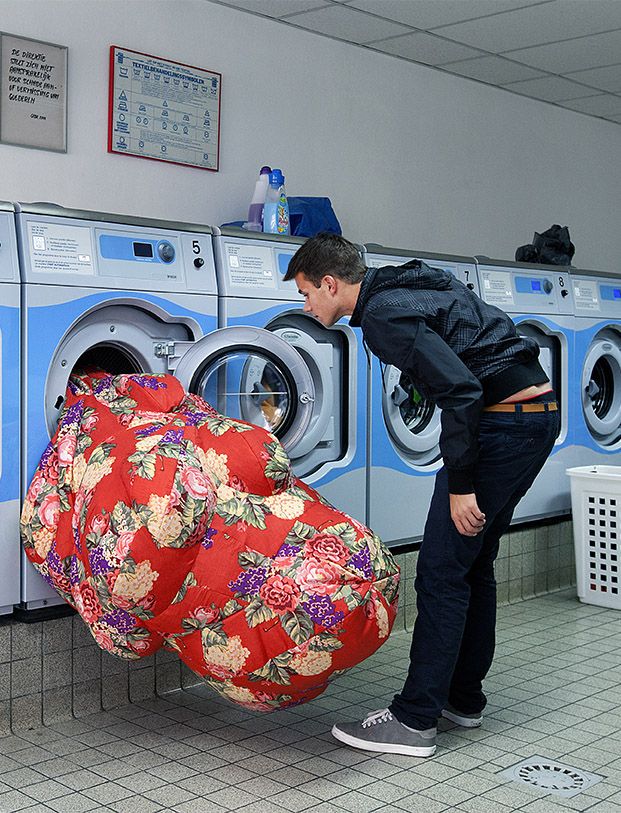
Emilie Faïf (FR) UNTITLED - EMILIE, 2013
Textile Installation,
Zeilstraat 13, Amsterdam
The French artist Emilie Faïf does performances, creates sculptures and installations and also provides scenography. Her poetic style results in textile installations with a dreamy character evocative of another world. The constructed artworks suggest the form of an object but the artist prefers to leave the work to the imagination of the viewer.
Faïf couples materiality and art as experience in the textile installation that she creates for KadS 2013. The work can be seen in the Wassalon Java laundrette in the
Zeilstraat number 13. The artist is fascinated by the social signature of textile and the layering of which is presented as a social good. Textile is not only a lovely piece of
fabric meant to protect man against the cold, the sun or the rain; it is also an identity-forming medium. The choice of a laundrette as a stage is a well considered one. Laundrettes are generally not deemed to be temples of art or fashion. They are a meeting point, an approachable place where local residents can wash their clothing. Occasionally, there is a long wait for the laundry, as a result of which boredom may be interspersed by chance encounters. Fabric, of fragile and soft materials creep out of
washing machines and are brought to life in a floating spatial sculpture linking the dynamics of the city with blissful dreams and idyllic nature.
Emilie Faïf [Paris, 1976] studied at the École des Arts Appliqués and L’École Nationale supérieure des Arts Décoratifs in Paris. She has made installations and designs for the
‘Galerie des Enfants’ in the Centre Pompidou, the French Ministry for Culture and the Public Offices for Social Housing (OPHLM). In addition to fine art projects, Faïf also works in commission for large fashion houses. She installs showrooms and window displays for Isabel Marant, Pierre Frey, Guerlain and Hermès, among others.
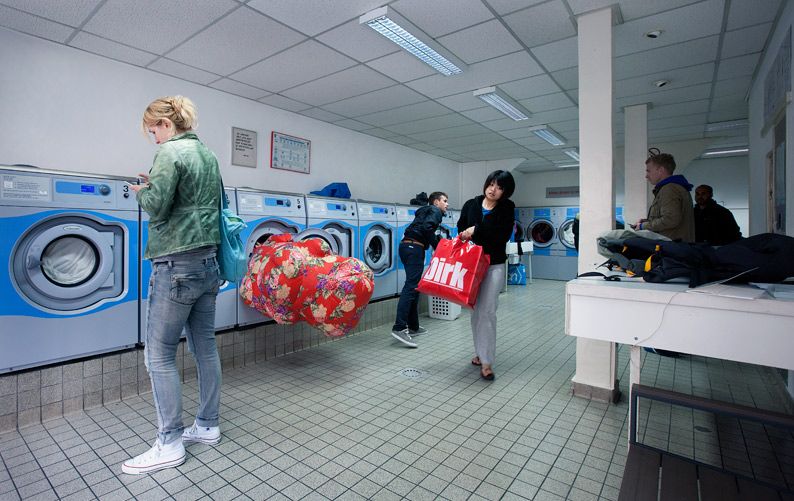
Emilie Faïf (FR) UNTITLED - EMILIE, 2013
Textile Installation,
Zeilstraat 13, Amsterdam
The French artist Emilie Faïf does performances, creates sculptures and installations and also provides scenography. Her poetic style results in textile installations with a dreamy character evocative of another world. The constructed artworks suggest the form of an object but the artist prefers to leave the work to the imagination of the viewer.
Faïf couples materiality and art as experience in the textile installation that she creates for KadS 2013. The work can be seen in the Wassalon Java laundrette in the
Zeilstraat number 13. The artist is fascinated by the social signature of textile and the layering of which is presented as a social good. Textile is not only a lovely piece of
fabric meant to protect man against the cold, the sun or the rain; it is also an identity-forming medium. The choice of a laundrette as a stage is a well considered one. Laundrettes are generally not deemed to be temples of art or fashion. They are a meeting point, an approachable place where local residents can wash their clothing. Occasionally, there is a long wait for the laundry, as a result of which boredom may be interspersed by chance encounters. Fabric, of fragile and soft materials creep out of
washing machines and are brought to life in a floating spatial sculpture linking the dynamics of the city with blissful dreams and idyllic nature.
Emilie Faïf [Paris, 1976] studied at the École des Arts Appliqués and L’École Nationale supérieure des Arts Décoratifs in Paris. She has made installations and designs for the
‘Galerie des Enfants’ in the Centre Pompidou, the French Ministry for Culture and the Public Offices for Social Housing (OPHLM). In addition to fine art projects, Faïf also works in commission for large fashion houses. She installs showrooms and window displays for Isabel Marant, Pierre Frey, Guerlain and Hermès, among others.
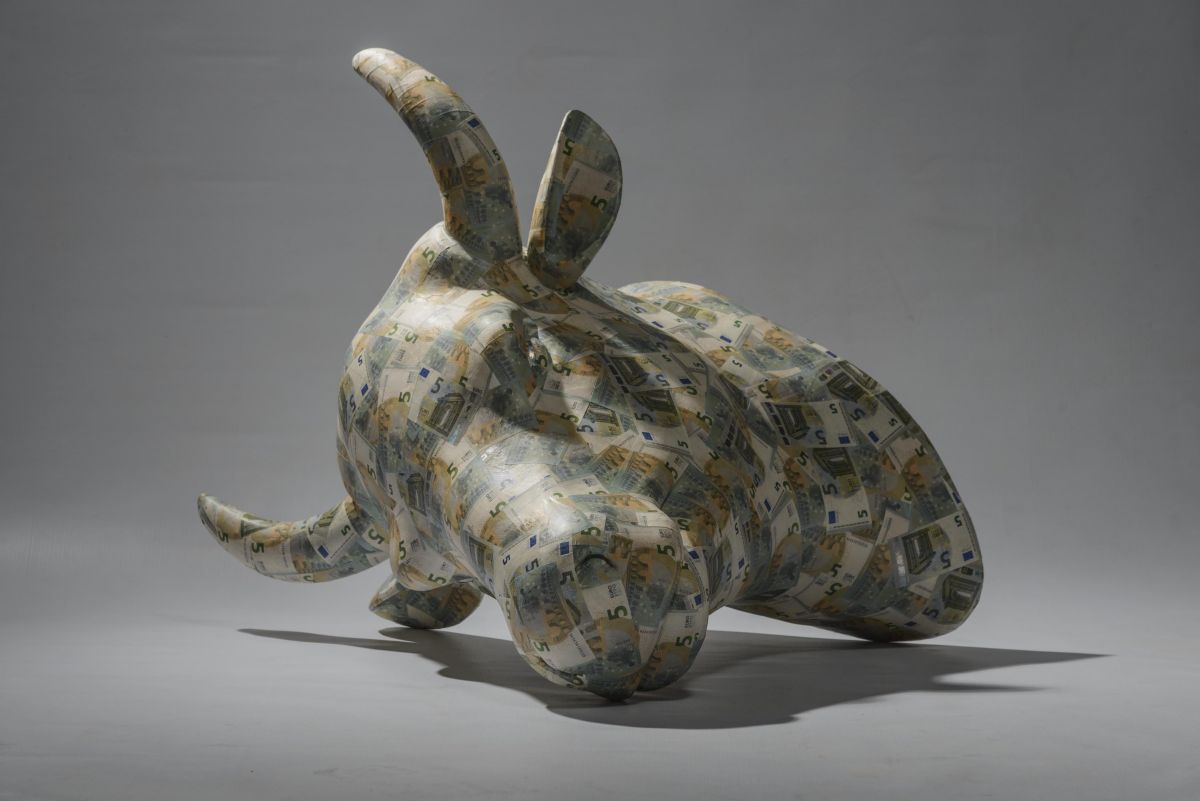
Greg Streak (SA) TO RENT: REMAINS OF THE CASH COW, 2013
Sculpture,
Zeilstraat 47-51, Amsterdam
The South African multidisciplinary artist Greg Streak works with video, sculpture and installations, and also makes documentaries. He has a fascination for aesthetic quality, materiality and the laborious nature of the making process. Upon closer examination it becomes clear that his work relates to – and is critical of – the reality that surrounds us. He exposes social-political notions on a micro and macro scale. The contrast between the work’s visually striking exterior and its intrinsic meaning sets the viewer on the wrong track.
For KadS, Streak is making a cow’s head that is larger than life, titled ‘To Rent: Remains of the Cash Cow’. The work not only deals with vacant spaces in the Schinkel neighbourhood, but also with the growing lack of occupancy visible around the world since the economic crisis of 2008. The cow’s head covered with 5-euro notes is placed in the shop-window of a vacant retail unit in the Zeilstraat. The work symbolises that a fixed return based on minimal effort has now become impossible. The metaphor of the ‘Cash Cow’ implies that a risk-free financial return is no longer a given.
Greg Streak [Bulawayo, Zimbabwe, 1971] studied at Natal Technikon in Durban and the Rijksakademie van beeldende kunsten in Amsterdam. In 2007, he was awarded an Ampersand Grant in New York. He is the founder of PUL SE, an arts initiative affiliated with the artists network, RAIN. He has organised numerous international projects
including the well-received Hiv[e] project in 2004 in South Africa. Streak has exhibited at 21 Rozendaal in Enschede and recently at Commune 1 Gallery in Cape Town, South Africa. The artist lives and works in Durban.
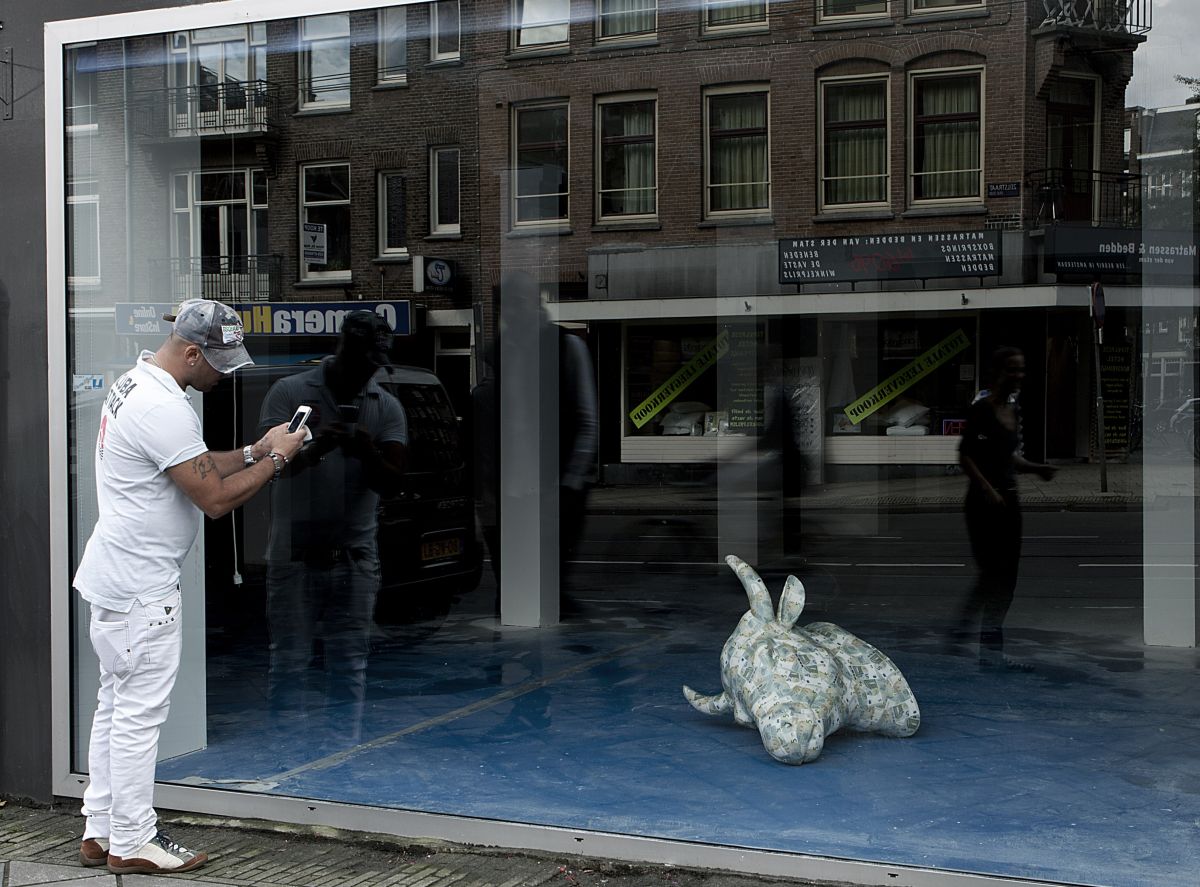
Greg Streak (SA) TO RENT: REMAINS OF THE CASH COW, 2013
Sculpture,
Zeilstraat 47-51, Amsterdam
The South African multidisciplinary artist Greg Streak works with video, sculpture and installations, and also makes documentaries. He has a fascination for aesthetic quality, materiality and the laborious nature of the making process. Upon closer examination it becomes clear that his work relates to – and is critical of – the reality that surrounds us. He exposes social-political notions on a micro and macro scale. The contrast between the work’s visually striking exterior and its intrinsic meaning sets the viewer on the wrong track.
For KadS, Streak is making a cow’s head that is larger than life, titled ‘To Rent: Remains of the Cash Cow’. The work not only deals with vacant spaces in the Schinkel neighbourhood, but also with the growing lack of occupancy visible around the world since the economic crisis of 2008. The cow’s head covered with 5-euro notes is placed in the shop-window of a vacant retail unit in the Zeilstraat. The work symbolises that a fixed return based on minimal effort has now become impossible. The metaphor of the ‘Cash Cow’ implies that a risk-free financial return is no longer a given.
Greg Streak [Bulawayo, Zimbabwe, 1971] studied at Natal Technikon in Durban and the Rijksakademie van beeldende kunsten in Amsterdam. In 2007, he was awarded an Ampersand Grant in New York. He is the founder of PUL SE, an arts initiative affiliated with the artists network, RAIN. He has organised numerous international projects
including the well-received Hiv[e] project in 2004 in South Africa. Streak has exhibited at 21 Rozendaal in Enschede and recently at Commune 1 Gallery in Cape Town, South Africa. The artist lives and works in Durban.
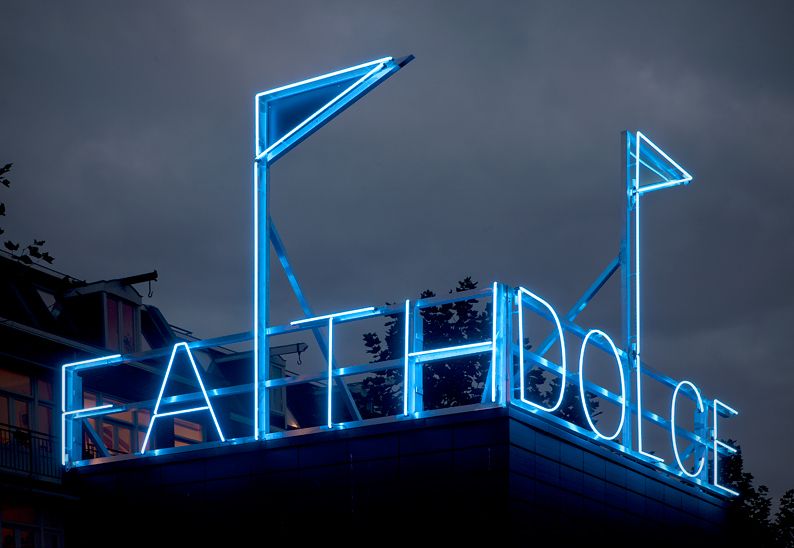
Jacqueline Dauriac (FR) FAITH DOLCE, 2013
Neon installation,
Zeilbrug, Amsterdam
The French visual artist Jacqueline Dauriac works within various disciplines of contemporary art, making use of new media and light. Her work is auditive, sensitive and perceptive. She engages with the artistic development of urban spaces, with which she aims to convey a sense of beauty and meaning to the visitor.
For KadS, Dauriac has developed a typographic installation of neon letters. The words Faith and Dolce are placed on top of the roof of the booth by the Zeilbrug a bridge over the Zeilstraat at Sloterkade 2. The light sculptures can be seen from various locations in the Schinkel neighbourhood. Their slender appearance and soft colour of light means that they’re also present in an unusual manner during the day as well as at night. Nowhere do they drown out the local atmosphere. The word ‘Faith’ evokes the association of integration of religions and ‘Dolce’ emphasises the quality of social contacts within the neighbourhood. The combination of the words references the sympathy that this neighbourhood exudes. The sounds of these words are very important says Dauriac, ‘Faith interrupts the flow of air and Dolce thankfully spreads it out again; together they provide a wonderful treaty for the future’. The words are crowned with a pointy neon flag.
Jacqueline Dauriac (1945, Tarbes) often works in the public space and has participated numerous times in Nuit Blanche in Paris with her monumental light installations.
She has exhibited internationally at Musée des Beaux-Arts in Rennes, Kunstverein Stuttgart and the Van Abbemuseum in Eindhoven, among others. Her work is also included in various corporate collections including CNAC Paris, FRAC , Rhône-Alpes, Museum Witte de With, Rotterdam, Collection Daniel Buren, Collection Balenciaga and Collection Pommery in Reims.
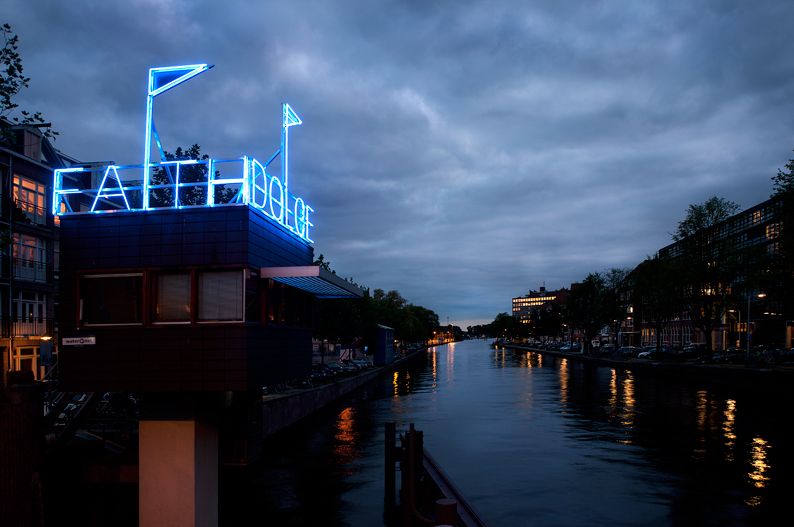
Jacqueline Dauriac (FR) FAITH DOLCE, 2013
Neon installation,
Zeilbrug, Amsterdam
The French visual artist Jacqueline Dauriac works within various disciplines of contemporary art, making use of new media and light. Her work is auditive, sensitive and perceptive. She engages with the artistic development of urban spaces, with which she aims to convey a sense of beauty and meaning to the visitor.
For KadS, Dauriac has developed a typographic installation of neon letters. The words Faith and Dolce are placed on top of the roof of the booth by the Zeilbrug a bridge over the Zeilstraat at Sloterkade 2. The light sculptures can be seen from various locations in the Schinkel neighbourhood. Their slender appearance and soft colour of light means that they’re also present in an unusual manner during the day as well as at night. Nowhere do they drown out the local atmosphere. The word ‘Faith’ evokes the association of integration of religions and ‘Dolce’ emphasises the quality of social contacts within the neighbourhood. The combination of the words references the sympathy that this neighbourhood exudes. The sounds of these words are very important says Dauriac, ‘Faith interrupts the flow of air and Dolce thankfully spreads it out again; together they provide a wonderful treaty for the future’. The words are crowned with a pointy neon flag.
Jacqueline Dauriac (1945, Tarbes) often works in the public space and has participated numerous times in Nuit Blanche in Paris with her monumental light installations.
She has exhibited internationally at Musée des Beaux-Arts in Rennes, Kunstverein Stuttgart and the Van Abbemuseum in Eindhoven, among others. Her work is also included in various corporate collections including CNAC Paris, FRAC , Rhône-Alpes, Museum Witte de With, Rotterdam, Collection Daniel Buren, Collection Balenciaga and Collection Pommery in Reims.
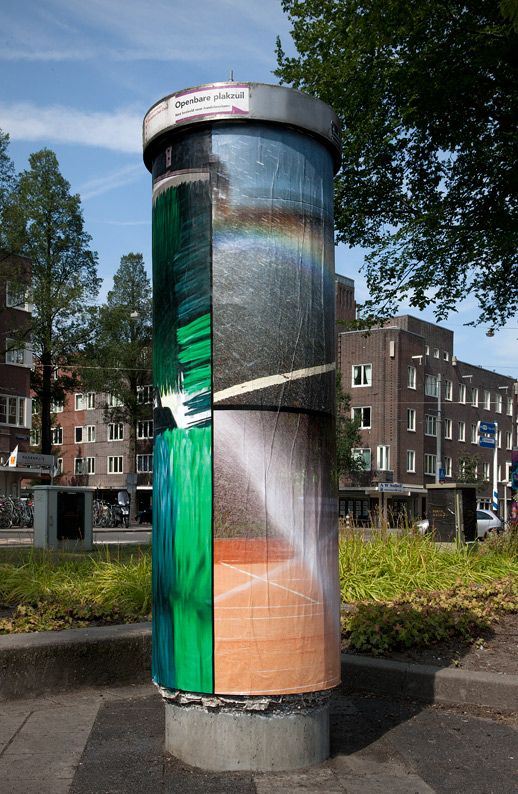
Marike Schuurman (NL) HEAT WAVE, 2013
Photography,
Schinkelkade opposite #20, Amsterdam
Photographer Marike Schuurman beholds the world in an unusual manner. The seemingly abstract elements in her work refer to the world around us. She unravels what she sees and places this in another context; in doing so she reveals the hidden beauties beauty of the everyday.
The series of photographs entitled ‘Heat Wave’, which Schuurman presents during KadS, form an attentive account of her wanderings through the Schinkel neighbourhood during the hottest week of 2013. The axis of the neighbourhood is the Schinkel, a canalised river. Water in all its facets plays a prominent yet not an obvious role in her series of photographs. Such as the cooling of the Zeilbrug (the bridge over the Zeilstraat); a car driving through a puddle of water creating a rainbow; or a floating soap bubble. Without any form of staging Schuurman made photographs in the Schinkel neighbourhood, of which the environment is not always recognisable in the image. The photographs are presented life-size on round, monumental pillars across various locations in the Schinkel neighbourhood, appearing to be three-dimensional as well as an addition to the environment. A number of photographs from the ‘Heat Wave’ series is displayed together in the shop window of the Hema, which will be transformed into the smallest public gallery in the Schinkel neighbourhood.
Marike Schuurman [Groningen, 1964] studied at the Vrije Academie in The Hague, the Gerrit Rietveld Academie and the Rijksakademie van beeldende kunsten in Amsterdam. She has participated in various international artist residencies. Her work is included in the corporate collections of the Ministry of Foreign Affairs in The Hague, the KPN collection and Sammlung Hoffmann in Berlin, among others. Marike Schuurman lives and works in Amsterdam and Berlin.
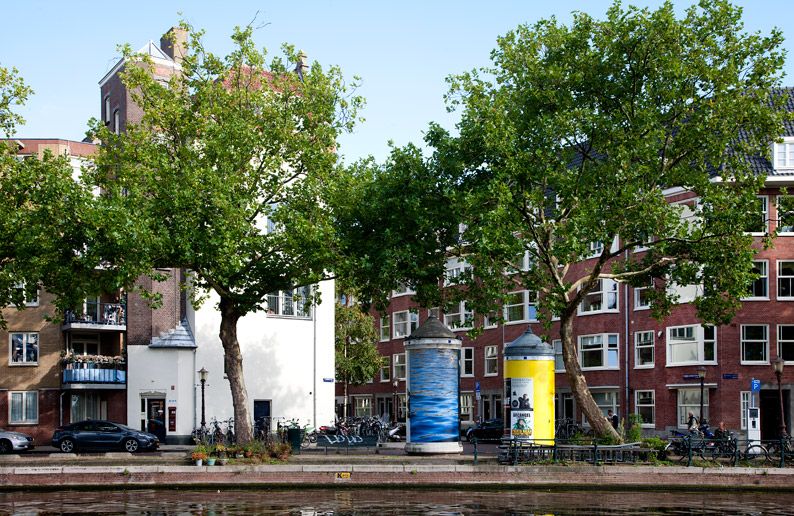
Marike Schuurman (NL) HEAT WAVE, 2013
Photography,
Schinkelkade opposite #20, Amsterdam
Photographer Marike Schuurman beholds the world in an unusual manner. The seemingly abstract elements in her work refer to the world around us. She unravels what she sees and places this in another context; in doing so she reveals the hidden beauties beauty of the everyday.
The series of photographs entitled ‘Heat Wave’, which Schuurman presents during KadS, form an attentive account of her wanderings through the Schinkel neighbourhood during the hottest week of 2013. The axis of the neighbourhood is the Schinkel, a canalised river. Water in all its facets plays a prominent yet not an obvious role in her series of photographs. Such as the cooling of the Zeilbrug (the bridge over the Zeilstraat); a car driving through a puddle of water creating a rainbow; or a floating soap bubble. Without any form of staging Schuurman made photographs in the Schinkel neighbourhood, of which the environment is not always recognisable in the image. The photographs are presented life-size on round, monumental pillars across various locations in the Schinkel neighbourhood, appearing to be three-dimensional as well as an addition to the environment. A number of photographs from the ‘Heat Wave’ series is displayed together in the shop window of the Hema, which will be transformed into the smallest public gallery in the Schinkel neighbourhood.
Marike Schuurman [Groningen, 1964] studied at the Vrije Academie in The Hague, the Gerrit Rietveld Academie and the Rijksakademie van beeldende kunsten in Amsterdam. She has participated in various international artist residencies. Her work is included in the corporate collections of the Ministry of Foreign Affairs in The Hague, the KPN collection and Sammlung Hoffmann in Berlin, among others. Marike Schuurman lives and works in Amsterdam and Berlin.
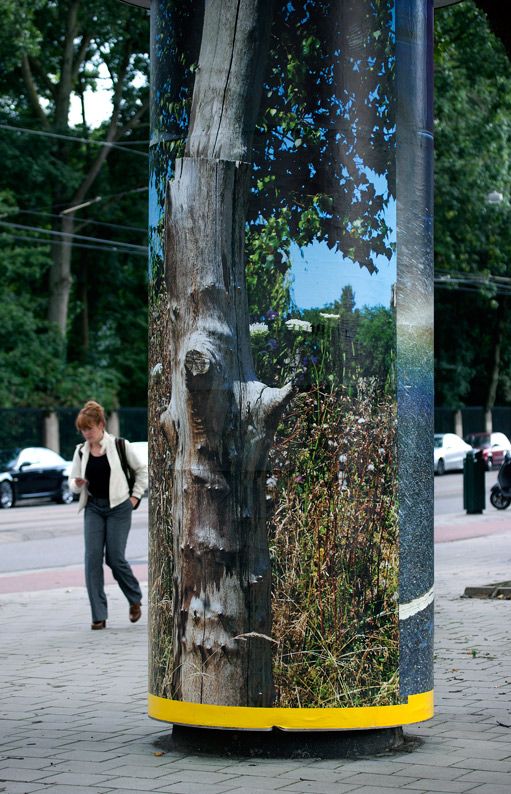
Marike Schuurman (NL) HEAT WAVE, 2013
Photography,
Schinkelkade opposite #20, Amsterdam
Photographer Marike Schuurman beholds the world in an unusual manner. The seemingly abstract elements in her work refer to the world around us. She unravels what she sees and places this in another context; in doing so she reveals the hidden beauties beauty of the everyday.
The series of photographs entitled ‘Heat Wave’, which Schuurman presents during KadS, form an attentive account of her wanderings through the Schinkel neighbourhood during the hottest week of 2013. The axis of the neighbourhood is the Schinkel, a canalised river. Water in all its facets plays a prominent yet not an obvious role in her series of photographs. Such as the cooling of the Zeilbrug (the bridge over the Zeilstraat); a car driving through a puddle of water creating a rainbow; or a floating soap bubble. Without any form of staging Schuurman made photographs in the Schinkel neighbourhood, of which the environment is not always recognisable in the image. The photographs are presented life-size on round, monumental pillars across various locations in the Schinkel neighbourhood, appearing to be three-dimensional as well as an addition to the environment. A number of photographs from the ‘Heat Wave’ series is displayed together in the shop window of the Hema, which will be transformed into the smallest public gallery in the Schinkel neighbourhood.
Marike Schuurman [Groningen, 1964] studied at the Vrije Academie in The Hague, the Gerrit Rietveld Academie and the Rijksakademie van beeldende kunsten in Amsterdam. She has participated in various international artist residencies. Her work is included in the corporate collections of the Ministry of Foreign Affairs in The Hague, the KPN collection and Sammlung Hoffmann in Berlin, among others. Marike Schuurman lives and works in Amsterdam and Berlin.
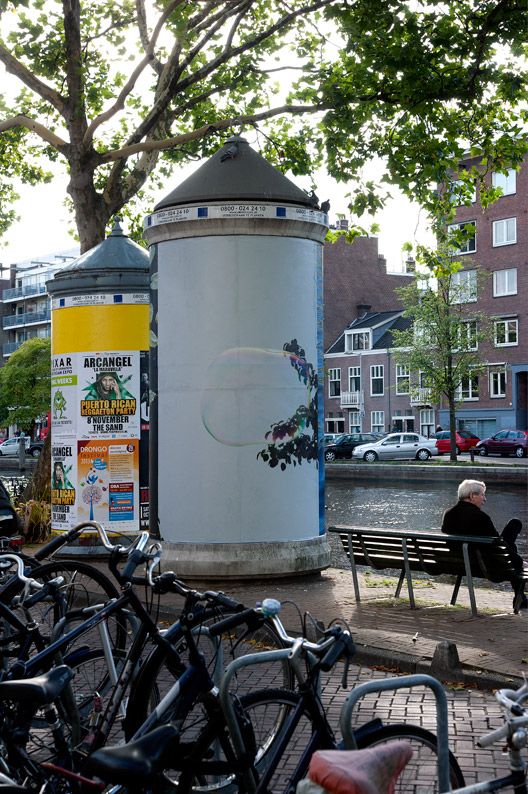
Marike Schuurman (NL) HEAT WAVE, 2013
Photography,
Schinkelkade opposite #20, Amsterdam
Photographer Marike Schuurman beholds the world in an unusual manner. The seemingly abstract elements in her work refer to the world around us. She unravels what she sees and places this in another context; in doing so she reveals the hidden beauties beauty of the everyday.
The series of photographs entitled ‘Heat Wave’, which Schuurman presents during KadS, form an attentive account of her wanderings through the Schinkel neighbourhood during the hottest week of 2013. The axis of the neighbourhood is the Schinkel, a canalised river. Water in all its facets plays a prominent yet not an obvious role in her series of photographs. Such as the cooling of the Zeilbrug (the bridge over the Zeilstraat); a car driving through a puddle of water creating a rainbow; or a floating soap bubble. Without any form of staging Schuurman made photographs in the Schinkel neighbourhood, of which the environment is not always recognisable in the image. The photographs are presented life-size on round, monumental pillars across various locations in the Schinkel neighbourhood, appearing to be three-dimensional as well as an addition to the environment. A number of photographs from the ‘Heat Wave’ series is displayed together in the shop window of the Hema, which will be transformed into the smallest public gallery in the Schinkel neighbourhood.
Marike Schuurman [Groningen, 1964] studied at the Vrije Academie in The Hague, the Gerrit Rietveld Academie and the Rijksakademie van beeldende kunsten in Amsterdam. She has participated in various international artist residencies. Her work is included in the corporate collections of the Ministry of Foreign Affairs in The Hague, the KPN collection and Sammlung Hoffmann in Berlin, among others. Marike Schuurman lives and works in Amsterdam and Berlin.
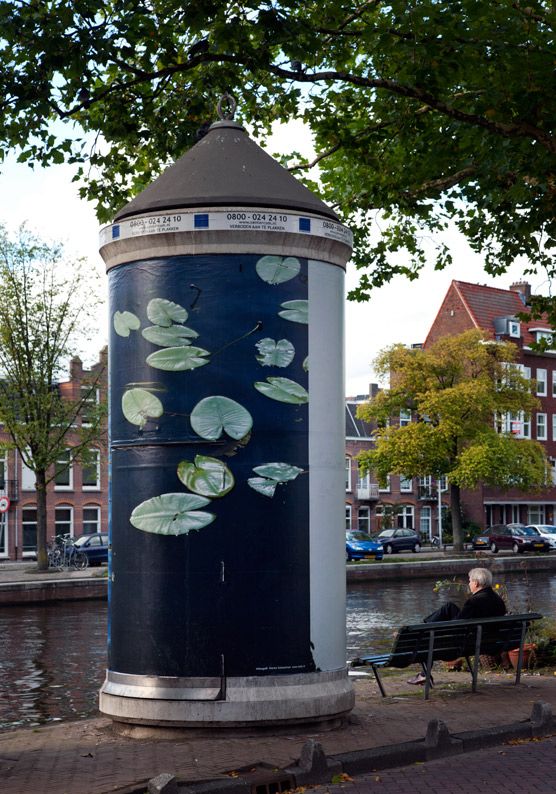
Marike Schuurman (NL) HEAT WAVE, 2013
Photography,
Schinkelkade opposite #20, Amsterdam
Photographer Marike Schuurman beholds the world in an unusual manner. The seemingly abstract elements in her work refer to the world around us. She unravels what she sees and places this in another context; in doing so she reveals the hidden beauties beauty of the everyday.
The series of photographs entitled ‘Heat Wave’, which Schuurman presents during KadS, form an attentive account of her wanderings through the Schinkel neighbourhood during the hottest week of 2013. The axis of the neighbourhood is the Schinkel, a canalised river. Water in all its facets plays a prominent yet not an obvious role in her series of photographs. Such as the cooling of the Zeilbrug (the bridge over the Zeilstraat); a car driving through a puddle of water creating a rainbow; or a floating soap bubble. Without any form of staging Schuurman made photographs in the Schinkel neighbourhood, of which the environment is not always recognisable in the image. The photographs are presented life-size on round, monumental pillars across various locations in the Schinkel neighbourhood, appearing to be three-dimensional as well as an addition to the environment. A number of photographs from the ‘Heat Wave’ series is displayed together in the shop window of the Hema, which will be transformed into the smallest public gallery in the Schinkel neighbourhood.
Marike Schuurman [Groningen, 1964] studied at the Vrije Academie in The Hague, the Gerrit Rietveld Academie and the Rijksakademie van beeldende kunsten in Amsterdam. She has participated in various international artist residencies. Her work is included in the corporate collections of the Ministry of Foreign Affairs in The Hague, the KPN collection and Sammlung Hoffmann in Berlin, among others. Marike Schuurman lives and works in Amsterdam and Berlin.
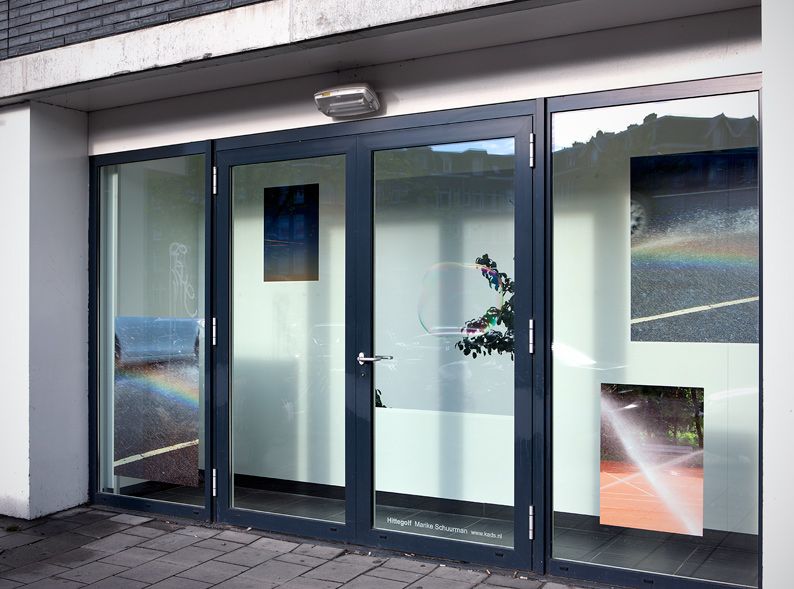
Marike Schuurman (NL) HEAT WAVE, 2013
Photography,
Schinkelkade opposite #20, Amsterdam
Photographer Marike Schuurman beholds the world in an unusual manner. The seemingly abstract elements in her work refer to the world around us. She unravels what she sees and places this in another context; in doing so she reveals the hidden beauties beauty of the everyday.
The series of photographs entitled ‘Heat Wave’, which Schuurman presents during KadS, form an attentive account of her wanderings through the Schinkel neighbourhood during the hottest week of 2013. The axis of the neighbourhood is the Schinkel, a canalised river. Water in all its facets plays a prominent yet not an obvious role in her series of photographs. Such as the cooling of the Zeilbrug (the bridge over the Zeilstraat); a car driving through a puddle of water creating a rainbow; or a floating soap bubble. Without any form of staging Schuurman made photographs in the Schinkel neighbourhood, of which the environment is not always recognisable in the image. The photographs are presented life-size on round, monumental pillars across various locations in the Schinkel neighbourhood, appearing to be three-dimensional as well as an addition to the environment. A number of photographs from the ‘Heat Wave’ series is displayed together in the shop window of the Hema, which will be transformed into the smallest public gallery in the Schinkel neighbourhood.
Marike Schuurman [Groningen, 1964] studied at the Vrije Academie in The Hague, the Gerrit Rietveld Academie and the Rijksakademie van beeldende kunsten in Amsterdam. She has participated in various international artist residencies. Her work is included in the corporate collections of the Ministry of Foreign Affairs in The Hague, the KPN collection and Sammlung Hoffmann in Berlin, among others. Marike Schuurman lives and works in Amsterdam and Berlin.
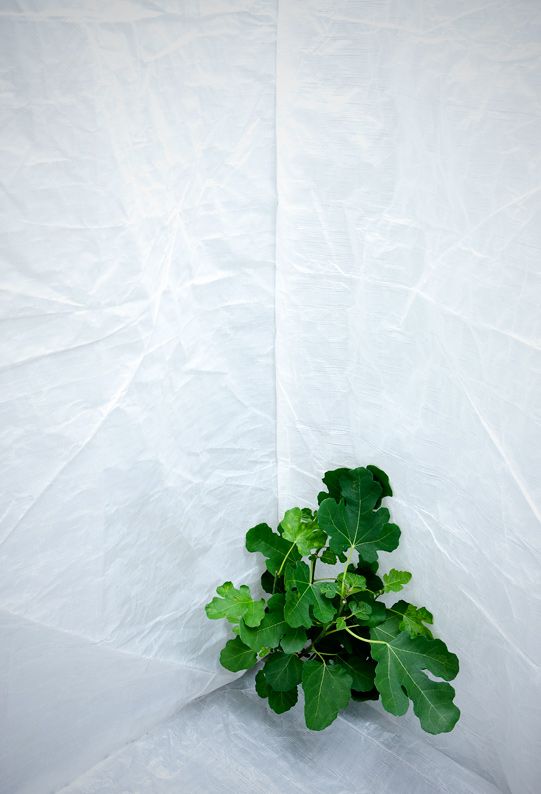
Pieter Alexander Lefebvre (NL) BIOTHEEK, 2013
Installation,
Sloterkade 171, Amsterdam
Architect Pieter Alexander Lefebvre and landscape architect Thijs de Zeeuw form a design duo that examines and renders visible the process of assimilation between the city and its flora and fauna. Urban nature has the tendency to not always be recognisable as ‘nature’. The city’s driving and dominating character imposes restrictions on the existing flora and fauna. As a result, nature in the city explores the boundaries of its biotope. The way in which this process unfolds, is the subject of the installation titled ‘Biotheek’ (Bio-Library/ Archive), which Lefebvre and De Zeeuw are presenting in the gallery space of Soledad Senlle Art Foundation.
The installation for KadS is made up of container linings: bags with the universal measurements of a sea container. The lining is an untouched space, which can easily be adapted and filled in a variety of ways. The U-form installation, which visitors can walk through, contains simulated urban conditions. Edges, paving patterns, skirting boards and walls form diverse ecological niches, in which the conditions of damp, light and nutrients for the urban plants vary. The framework for the urban vegetation is site-specific and generic at the same time. By taking the plants out of their urban context, the beauty of each individual plant is emphasised. The reciprocal influence of urban ecology is made visible in a truly unique manner.
L efebvre [Oegstgeest, 1977] studied architecture at TU Delft and has worked as an architect since 2004. During his study at the Sandberg Institute in Amsterdam he carried out research into assimilation as a design method. He formulated strategies for the temporary use of vacant buildings. Landscape architect Thijs de Zeeuw [Amsterdam, 1976] studied at the Academy of Architecture in Amsterdam and he is engaged with research into and the design of ecological systems. Urban nature is a recurring theme in his work.
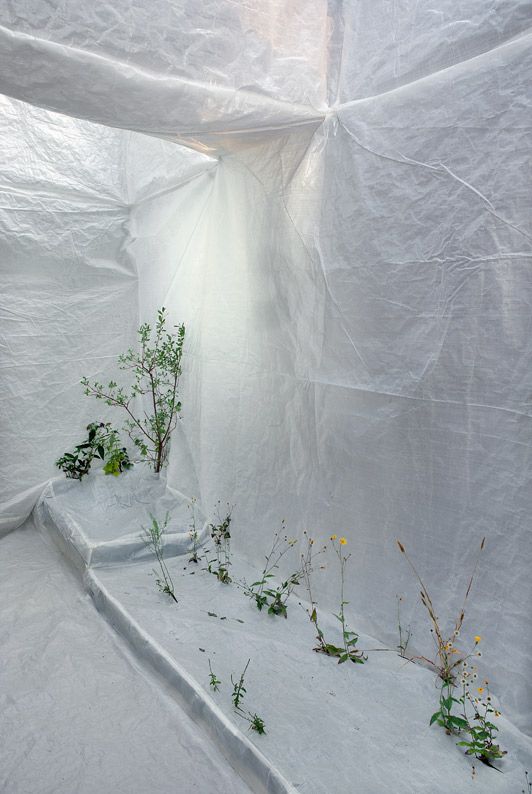
Pieter Alexander Lefebvre (NL) BIOTHEEK, 2013
Installation,
Sloterkade 171, Amsterdam
Architect Pieter Alexander Lefebvre and landscape architect Thijs de Zeeuw form a design duo that examines and renders visible the process of assimilation between the city and its flora and fauna. Urban nature has the tendency to not always be recognisable as ‘nature’. The city’s driving and dominating character imposes restrictions on the existing flora and fauna. As a result, nature in the city explores the boundaries of its biotope. The way in which this process unfolds, is the subject of the installation titled ‘Biotheek’ (Bio-Library/ Archive), which Lefebvre and De Zeeuw are presenting in the gallery space of Soledad Senlle Art Foundation.
The installation for KadS is made up of container linings: bags with the universal measurements of a sea container. The lining is an untouched space, which can easily be adapted and filled in a variety of ways. The U-form installation, which visitors can walk through, contains simulated urban conditions. Edges, paving patterns, skirting boards and walls form diverse ecological niches, in which the conditions of damp, light and nutrients for the urban plants vary. The framework for the urban vegetation is site-specific and generic at the same time. By taking the plants out of their urban context, the beauty of each individual plant is emphasised. The reciprocal influence of urban ecology is made visible in a truly unique manner.
L efebvre [Oegstgeest, 1977] studied architecture at TU Delft and has worked as an architect since 2004. During his study at the Sandberg Institute in Amsterdam he carried out research into assimilation as a design method. He formulated strategies for the temporary use of vacant buildings. Landscape architect Thijs de Zeeuw [Amsterdam, 1976] studied at the Academy of Architecture in Amsterdam and he is engaged with research into and the design of ecological systems. Urban nature is a recurring theme in his work.
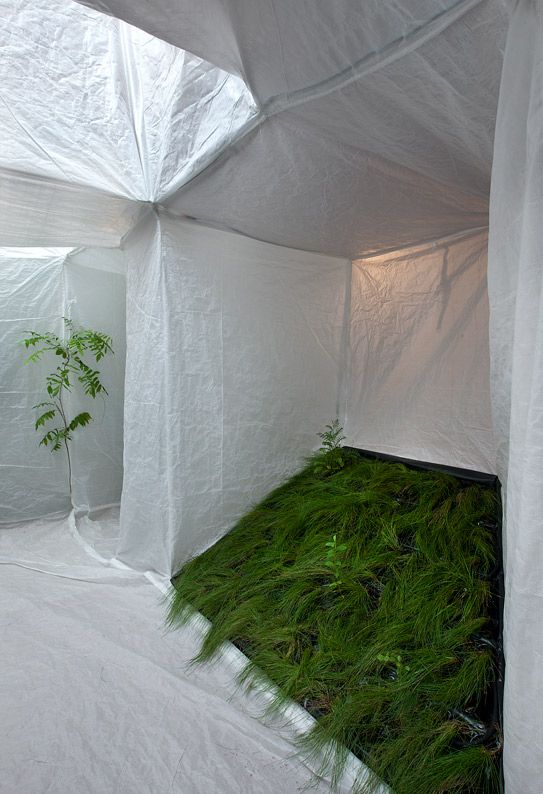
Pieter Alexander Lefebvre (NL) BIOTHEEK, 2013
Installation,
Sloterkade 171, Amsterdam
Architect Pieter Alexander Lefebvre and landscape architect Thijs de Zeeuw form a design duo that examines and renders visible the process of assimilation between the city and its flora and fauna. Urban nature has the tendency to not always be recognisable as ‘nature’. The city’s driving and dominating character imposes restrictions on the existing flora and fauna. As a result, nature in the city explores the boundaries of its biotope. The way in which this process unfolds, is the subject of the installation titled ‘Biotheek’ (Bio-Library/ Archive), which Lefebvre and De Zeeuw are presenting in the gallery space of Soledad Senlle Art Foundation.
The installation for KadS is made up of container linings: bags with the universal measurements of a sea container. The lining is an untouched space, which can easily be adapted and filled in a variety of ways. The U-form installation, which visitors can walk through, contains simulated urban conditions. Edges, paving patterns, skirting boards and walls form diverse ecological niches, in which the conditions of damp, light and nutrients for the urban plants vary. The framework for the urban vegetation is site-specific and generic at the same time. By taking the plants out of their urban context, the beauty of each individual plant is emphasised. The reciprocal influence of urban ecology is made visible in a truly unique manner.
L efebvre [Oegstgeest, 1977] studied architecture at TU Delft and has worked as an architect since 2004. During his study at the Sandberg Institute in Amsterdam he carried out research into assimilation as a design method. He formulated strategies for the temporary use of vacant buildings. Landscape architect Thijs de Zeeuw [Amsterdam, 1976] studied at the Academy of Architecture in Amsterdam and he is engaged with research into and the design of ecological systems. Urban nature is a recurring theme in his work.
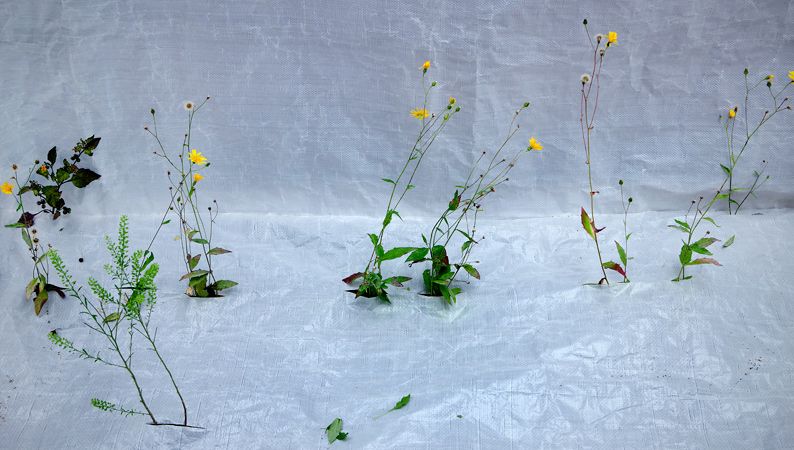
Pieter Alexander Lefebvre (NL) BIOTHEEK, 2013
Installation,
Sloterkade 171, Amsterdam
Architect Pieter Alexander Lefebvre and landscape architect Thijs de Zeeuw form a design duo that examines and renders visible the process of assimilation between the city and its flora and fauna. Urban nature has the tendency to not always be recognisable as ‘nature’. The city’s driving and dominating character imposes restrictions on the existing flora and fauna. As a result, nature in the city explores the boundaries of its biotope. The way in which this process unfolds, is the subject of the installation titled ‘Biotheek’ (Bio-Library/ Archive), which Lefebvre and De Zeeuw are presenting in the gallery space of Soledad Senlle Art Foundation.
The installation for KadS is made up of container linings: bags with the universal measurements of a sea container. The lining is an untouched space, which can easily be adapted and filled in a variety of ways. The U-form installation, which visitors can walk through, contains simulated urban conditions. Edges, paving patterns, skirting boards and walls form diverse ecological niches, in which the conditions of damp, light and nutrients for the urban plants vary. The framework for the urban vegetation is site-specific and generic at the same time. By taking the plants out of their urban context, the beauty of each individual plant is emphasised. The reciprocal influence of urban ecology is made visible in a truly unique manner.
L efebvre [Oegstgeest, 1977] studied architecture at TU Delft and has worked as an architect since 2004. During his study at the Sandberg Institute in Amsterdam he carried out research into assimilation as a design method. He formulated strategies for the temporary use of vacant buildings. Landscape architect Thijs de Zeeuw [Amsterdam, 1976] studied at the Academy of Architecture in Amsterdam and he is engaged with research into and the design of ecological systems. Urban nature is a recurring theme in his work.
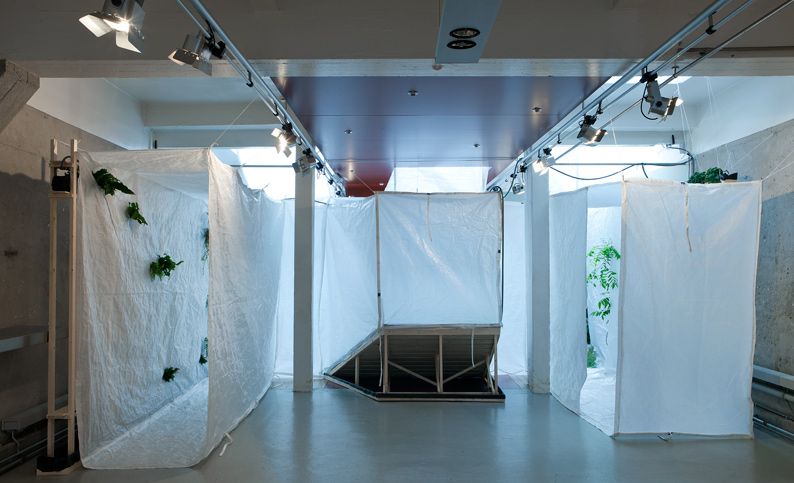
Pieter Alexander Lefebvre (NL) BIOTHEEK, 2013
Installation,
Sloterkade 171, Amsterdam
Architect Pieter Alexander Lefebvre and landscape architect Thijs de Zeeuw form a design duo that examines and renders visible the process of assimilation between the city and its flora and fauna. Urban nature has the tendency to not always be recognisable as ‘nature’. The city’s driving and dominating character imposes restrictions on the existing flora and fauna. As a result, nature in the city explores the boundaries of its biotope. The way in which this process unfolds, is the subject of the installation titled ‘Biotheek’ (Bio-Library/ Archive), which Lefebvre and De Zeeuw are presenting in the gallery space of Soledad Senlle Art Foundation.
The installation for KadS is made up of container linings: bags with the universal measurements of a sea container. The lining is an untouched space, which can easily be adapted and filled in a variety of ways. The U-form installation, which visitors can walk through, contains simulated urban conditions. Edges, paving patterns, skirting boards and walls form diverse ecological niches, in which the conditions of damp, light and nutrients for the urban plants vary. The framework for the urban vegetation is site-specific and generic at the same time. By taking the plants out of their urban context, the beauty of each individual plant is emphasised. The reciprocal influence of urban ecology is made visible in a truly unique manner.
L efebvre [Oegstgeest, 1977] studied architecture at TU Delft and has worked as an architect since 2004. During his study at the Sandberg Institute in Amsterdam he carried out research into assimilation as a design method. He formulated strategies for the temporary use of vacant buildings. Landscape architect Thijs de Zeeuw [Amsterdam, 1976] studied at the Academy of Architecture in Amsterdam and he is engaged with research into and the design of ecological systems. Urban nature is a recurring theme in his work.
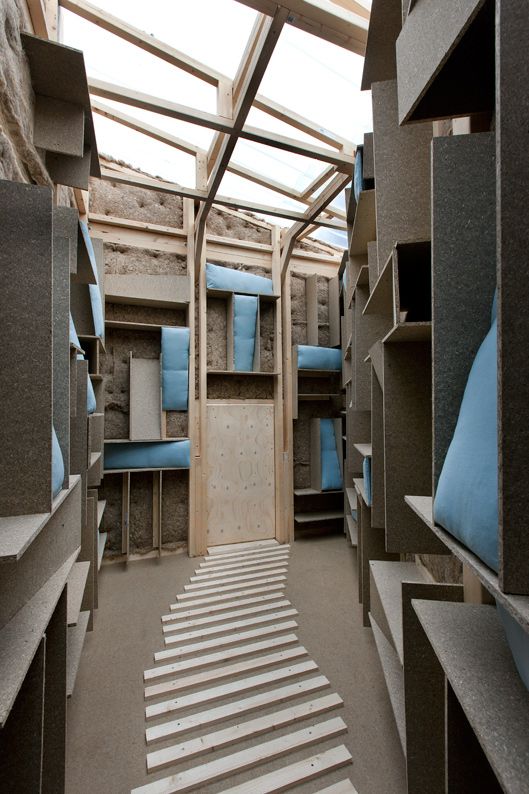
Sachi Myachi (JP) A QUIET WEDGE, 2013
Installation,
Hoofddorpplein, Amsterdam
Sachi Miyachi’s installations and performances are inspired by the meanings and functions of public and urban spaces in which she examines the position of man and his rituals. She ingeniously turns her fascination with this subject matter into sketches, structures and performances. After thorough research into her direct surroundings and the everyday actions and rituals linked to them, she subsequently seeks to interact with her public. Miyachi uses spatial forms and locations both conceptually and perceptually. In doing so she raises visitors’ awareness by allowing her installations and activities to be experienced in an extraordinary manner.
For KadS 2013, Miyachi is building ‘The Hut -A quiet wedge’, a soundproof quiet house on the neighbourhood’s busiest traffic point. It is situated right on top of the roundabout on Hoofddorpplein; a square encircled day and night by trams, buses and cars. Miyachi was inspired by El Lissitzky’s ‘Beat the Whites with the Red Wedge’, a propaganda poster from 1919, which stood as a symbol for a new world brought about by the people. Miyachi’s work is infused with the notion: ‘Beat the noisy square with the quiet wedge’. The work symbolises her exploration of this urban area, where visitors are able to rediscover themselves amidst the hustle and bustle of mass society. After the daily workflow, the individual is able to renew his or her personal tempo and level of sensitivity in this structure. With this artistic intervention Miyachi creates a
context for interaction, participation and reflection.
Sachi Miyachi [Tokyo, Japan, 1978] studied fine art and anthropology at Wako University in Tokyo and Fine Art at the Gerrit Rietveld Academie and the Sandberg Institute in Amsterdam. In 2008, she won the AIA S Prize of Honour.
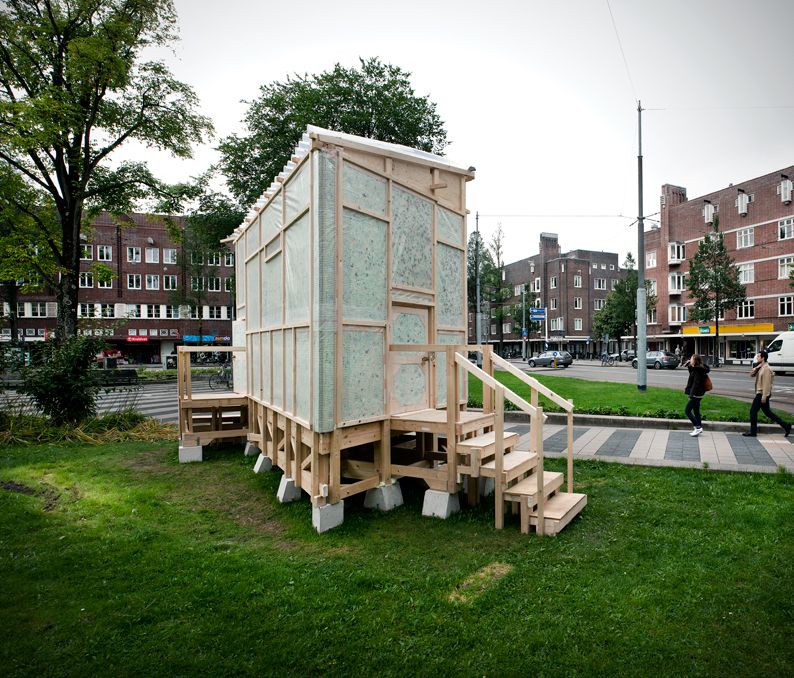
Sachi Myachi (JP) A QUIET WEDGE, 2013
Installation,
Hoofddorpplein, Amsterdam
Sachi Miyachi’s installations and performances are inspired by the meanings and functions of public and urban spaces in which she examines the position of man and his rituals. She ingeniously turns her fascination with this subject matter into sketches, structures and performances. After thorough research into her direct surroundings and the everyday actions and rituals linked to them, she subsequently seeks to interact with her public. Miyachi uses spatial forms and locations both conceptually and perceptually. In doing so she raises visitors’ awareness by allowing her installations and activities to be experienced in an extraordinary manner.
For KadS 2013, Miyachi is building ‘The Hut -A quiet wedge’, a soundproof quiet house on the neighbourhood’s busiest traffic point. It is situated right on top of the roundabout on Hoofddorpplein; a square encircled day and night by trams, buses and cars. Miyachi was inspired by El Lissitzky’s ‘Beat the Whites with the Red Wedge’, a propaganda poster from 1919, which stood as a symbol for a new world brought about by the people. Miyachi’s work is infused with the notion: ‘Beat the noisy square with the quiet wedge’. The work symbolises her exploration of this urban area, where visitors are able to rediscover themselves amidst the hustle and bustle of mass society. After the daily workflow, the individual is able to renew his or her personal tempo and level of sensitivity in this structure. With this artistic intervention Miyachi creates a
context for interaction, participation and reflection.
Sachi Miyachi [Tokyo, Japan, 1978] studied fine art and anthropology at Wako University in Tokyo and Fine Art at the Gerrit Rietveld Academie and the Sandberg Institute in Amsterdam. In 2008, she won the AIA S Prize of Honour.
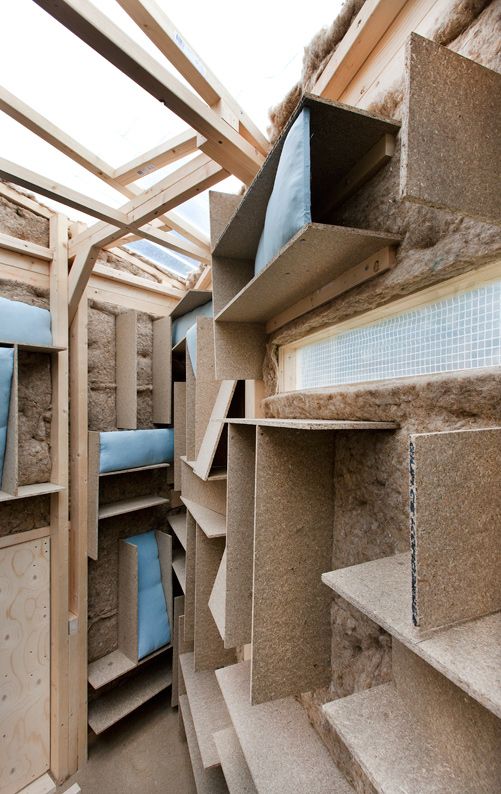
Sachi Myachi (JP) A QUIET WEDGE, 2013
Installation,
Hoofddorpplein, Amsterdam
Sachi Miyachi’s installations and performances are inspired by the meanings and functions of public and urban spaces in which she examines the position of man and his rituals. She ingeniously turns her fascination with this subject matter into sketches, structures and performances. After thorough research into her direct surroundings and the everyday actions and rituals linked to them, she subsequently seeks to interact with her public. Miyachi uses spatial forms and locations both conceptually and perceptually. In doing so she raises visitors’ awareness by allowing her installations and activities to be experienced in an extraordinary manner.
For KadS 2013, Miyachi is building ‘The Hut -A quiet wedge’, a soundproof quiet house on the neighbourhood’s busiest traffic point. It is situated right on top of the roundabout on Hoofddorpplein; a square encircled day and night by trams, buses and cars. Miyachi was inspired by El Lissitzky’s ‘Beat the Whites with the Red Wedge’, a propaganda poster from 1919, which stood as a symbol for a new world brought about by the people. Miyachi’s work is infused with the notion: ‘Beat the noisy square with the quiet wedge’. The work symbolises her exploration of this urban area, where visitors are able to rediscover themselves amidst the hustle and bustle of mass society. After the daily workflow, the individual is able to renew his or her personal tempo and level of sensitivity in this structure. With this artistic intervention Miyachi creates a
context for interaction, participation and reflection.
Sachi Miyachi [Tokyo, Japan, 1978] studied fine art and anthropology at Wako University in Tokyo and Fine Art at the Gerrit Rietveld Academie and the Sandberg Institute in Amsterdam. In 2008, she won the AIA S Prize of Honour.
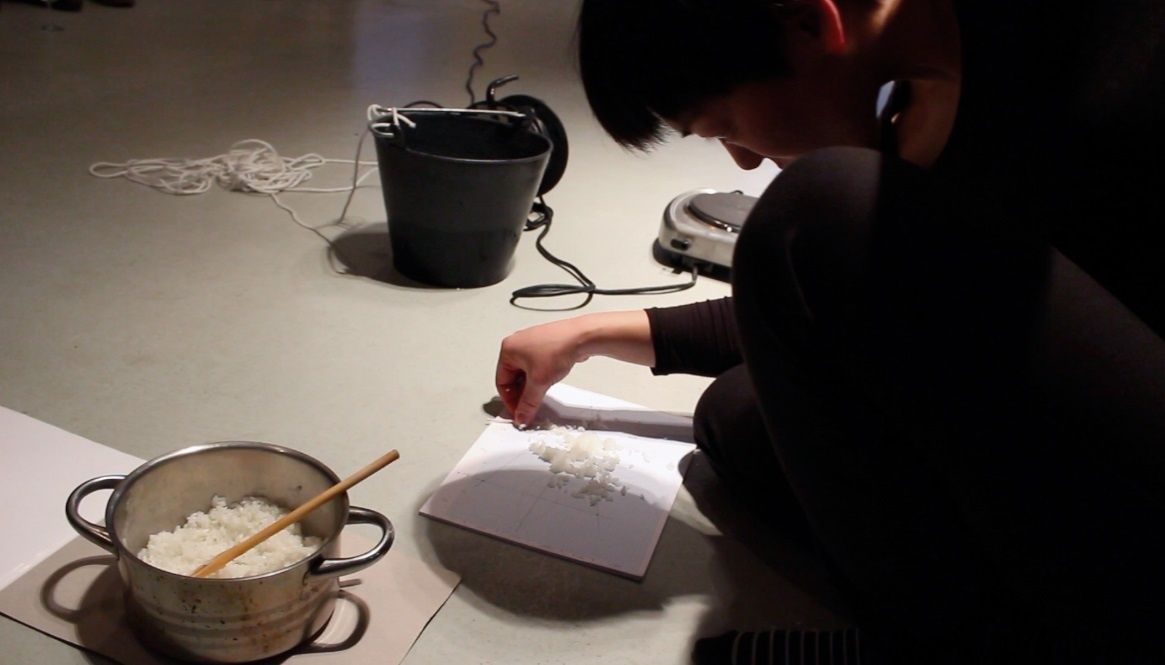
Sachi Myachi (JP) A QUIET WEDGE, 2013
Installation,
Hoofddorpplein, Amsterdam
Sachi Miyachi’s installations and performances are inspired by the meanings and functions of public and urban spaces in which she examines the position of man and his rituals. She ingeniously turns her fascination with this subject matter into sketches, structures and performances. After thorough research into her direct surroundings and the everyday actions and rituals linked to them, she subsequently seeks to interact with her public. Miyachi uses spatial forms and locations both conceptually and perceptually. In doing so she raises visitors’ awareness by allowing her installations and activities to be experienced in an extraordinary manner.
For KadS 2013, Miyachi is building ‘The Hut -A quiet wedge’, a soundproof quiet house on the neighbourhood’s busiest traffic point. It is situated right on top of the roundabout on Hoofddorpplein; a square encircled day and night by trams, buses and cars. Miyachi was inspired by El Lissitzky’s ‘Beat the Whites with the Red Wedge’, a propaganda poster from 1919, which stood as a symbol for a new world brought about by the people. Miyachi’s work is infused with the notion: ‘Beat the noisy square with the quiet wedge’. The work symbolises her exploration of this urban area, where visitors are able to rediscover themselves amidst the hustle and bustle of mass society. After the daily workflow, the individual is able to renew his or her personal tempo and level of sensitivity in this structure. With this artistic intervention Miyachi creates a
context for interaction, participation and reflection.
Sachi Miyachi [Tokyo, Japan, 1978] studied fine art and anthropology at Wako University in Tokyo and Fine Art at the Gerrit Rietveld Academie and the Sandberg Institute in Amsterdam. In 2008, she won the AIA S Prize of Honour.
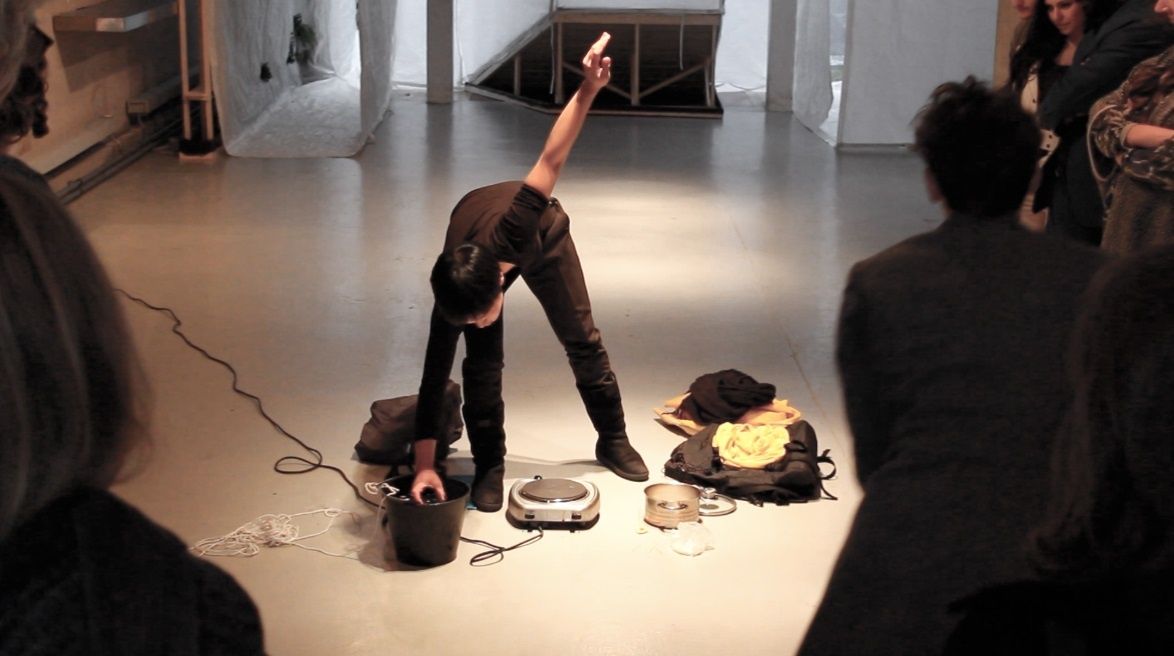
Sachi Myachi (JP) A QUIET WEDGE, 2013
Installation,
Hoofddorpplein, Amsterdam
Sachi Miyachi’s installations and performances are inspired by the meanings and functions of public and urban spaces in which she examines the position of man and his rituals. She ingeniously turns her fascination with this subject matter into sketches, structures and performances. After thorough research into her direct surroundings and the everyday actions and rituals linked to them, she subsequently seeks to interact with her public. Miyachi uses spatial forms and locations both conceptually and perceptually. In doing so she raises visitors’ awareness by allowing her installations and activities to be experienced in an extraordinary manner.
For KadS 2013, Miyachi is building ‘The Hut -A quiet wedge’, a soundproof quiet house on the neighbourhood’s busiest traffic point. It is situated right on top of the roundabout on Hoofddorpplein; a square encircled day and night by trams, buses and cars. Miyachi was inspired by El Lissitzky’s ‘Beat the Whites with the Red Wedge’, a propaganda poster from 1919, which stood as a symbol for a new world brought about by the people. Miyachi’s work is infused with the notion: ‘Beat the noisy square with the quiet wedge’. The work symbolises her exploration of this urban area, where visitors are able to rediscover themselves amidst the hustle and bustle of mass society. After the daily workflow, the individual is able to renew his or her personal tempo and level of sensitivity in this structure. With this artistic intervention Miyachi creates a
context for interaction, participation and reflection.
Sachi Miyachi [Tokyo, Japan, 1978] studied fine art and anthropology at Wako University in Tokyo and Fine Art at the Gerrit Rietveld Academie and the Sandberg Institute in Amsterdam. In 2008, she won the AIA S Prize of Honour.
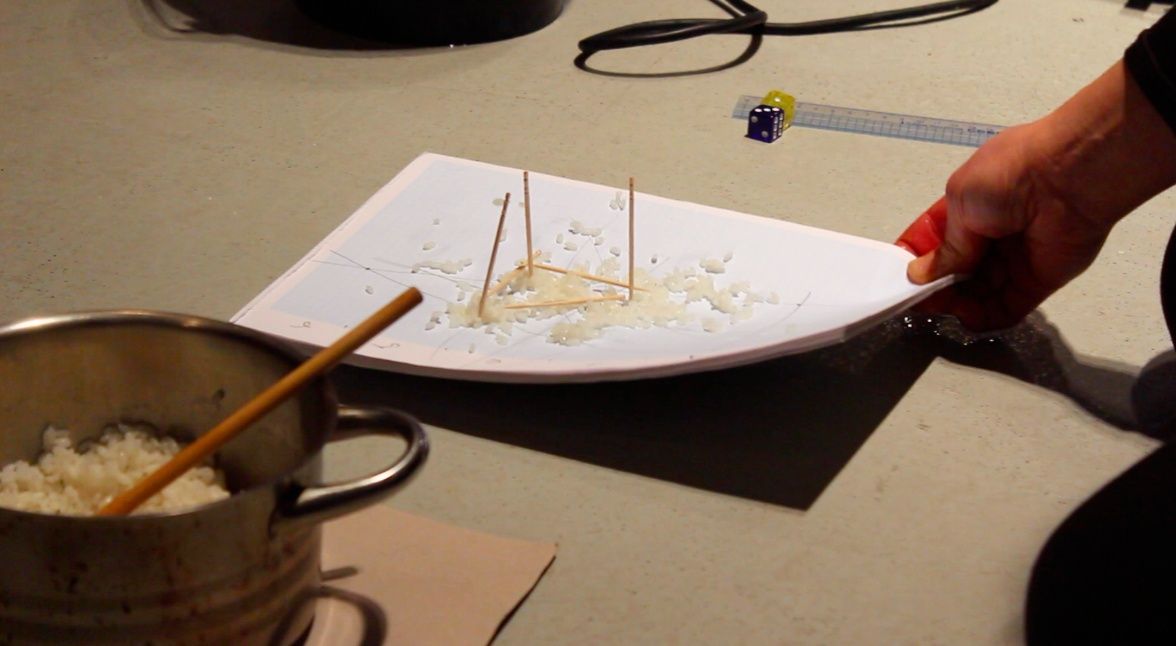
Sachi Myachi (JP) A QUIET WEDGE, 2013
Installation,
Hoofddorpplein, Amsterdam
Sachi Miyachi’s installations and performances are inspired by the meanings and functions of public and urban spaces in which she examines the position of man and his rituals. She ingeniously turns her fascination with this subject matter into sketches, structures and performances. After thorough research into her direct surroundings and the everyday actions and rituals linked to them, she subsequently seeks to interact with her public. Miyachi uses spatial forms and locations both conceptually and perceptually. In doing so she raises visitors’ awareness by allowing her installations and activities to be experienced in an extraordinary manner.
For KadS 2013, Miyachi is building ‘The Hut -A quiet wedge’, a soundproof quiet house on the neighbourhood’s busiest traffic point. It is situated right on top of the roundabout on Hoofddorpplein; a square encircled day and night by trams, buses and cars. Miyachi was inspired by El Lissitzky’s ‘Beat the Whites with the Red Wedge’, a propaganda poster from 1919, which stood as a symbol for a new world brought about by the people. Miyachi’s work is infused with the notion: ‘Beat the noisy square with the quiet wedge’. The work symbolises her exploration of this urban area, where visitors are able to rediscover themselves amidst the hustle and bustle of mass society. After the daily workflow, the individual is able to renew his or her personal tempo and level of sensitivity in this structure. With this artistic intervention Miyachi creates a
context for interaction, participation and reflection.
Sachi Miyachi [Tokyo, Japan, 1978] studied fine art and anthropology at Wako University in Tokyo and Fine Art at the Gerrit Rietveld Academie and the Sandberg Institute in Amsterdam. In 2008, she won the AIA S Prize of Honour.
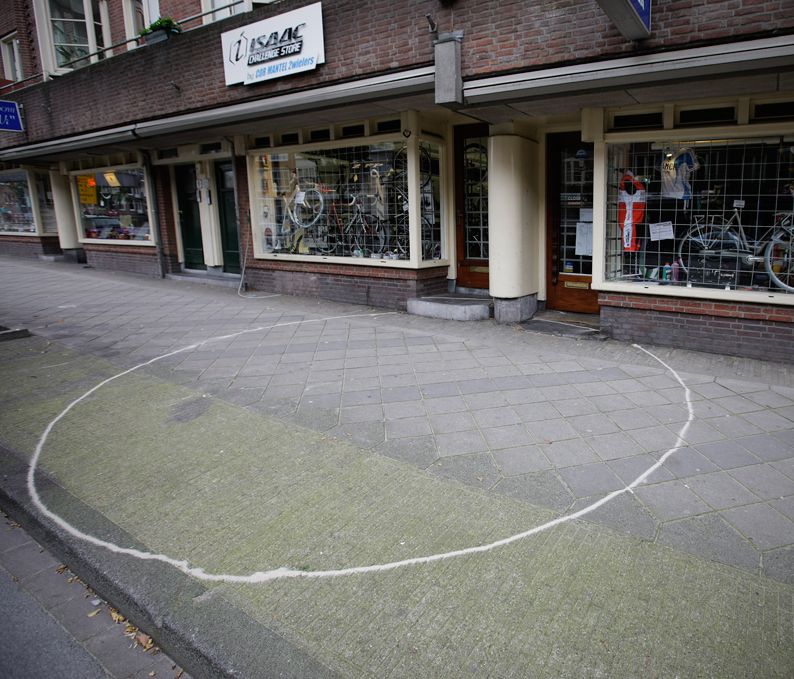
() Sandmapping, 2013
Performance,
Zeilstraat, Amsterdam
SandMapping is a global DIY collection of circles of sand. It exists both in public space and on the Internet. #SandMapping comprises of creating and photographing circular drawings with sand, using a PET (plastic) bottle filled with sand tied to a piece of rope.
Drawing the sand circles in public space feels somewhat unlawful, but actually results into some subtle graffiti that will dissapear by itself. By tagging the photos with #SandMapping, the online collection increases over time.
Several drawings were made in the Schinkel neighbourhood during the opening of KadS.
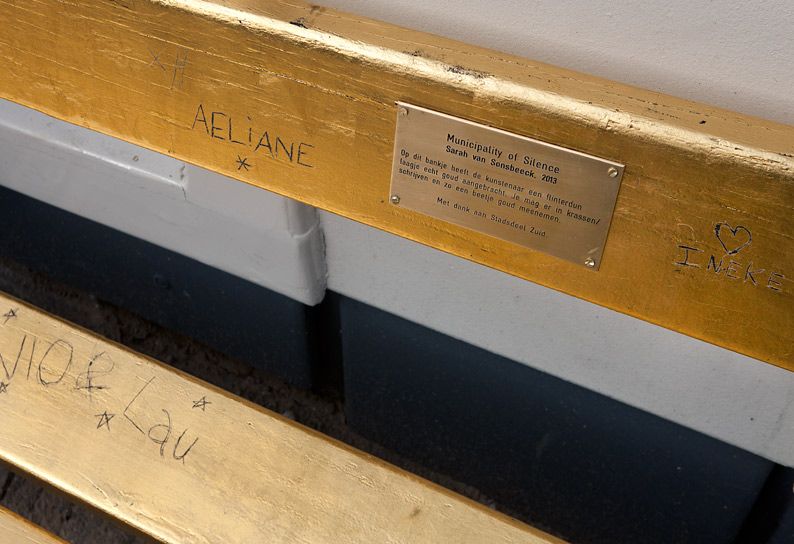
Sarah van Sonsbeeck (NL) MUNICIPALITY OF SILENCE, 2013
Sculpture,
Zeilstraat 54, Amsterdam
Sarah van Sonsbeeck has a background in architecture and fine art, and has therefore developed an interdisciplinary way of working. She has a detailed eye for the architectonic experience of her installations and focuses on silence, human interaction and the relational ownership of space. The conceptual character of her work shows a poetic sensibility, while her choices in form and materiality are both functional and well considered.
For KadS, Van Sonsbeeck is seeking to interact with the public. Her installation ‘Municipality of Silence’ comprises a municipal bench covered with 22-karat gold leaf, which is placed in front of a gold shop in the Zeilstraat. Gold is generally considered to be a safe investment. The work speaks to the imagination in this location, particularly in our current economic crisis. Visitors are invited to actively participate in the artwork by carving a message into the bench, and taking a bit of gold away with them. The artwork consists of the transformation of an everyday street object. Contributions made by visitors, who add their own stories, are an essential part of this transfiguration. As such, the ‘silent’ installation acquires a history, and hereby reveals a layering.
Sarah van Sonsbeeck [Utrecht, 1976] studied Architecture at TU Delft, and Fine Art at the Gerrit Rietveld Academie and the Rijksakademie van Beeldende Kunsten in Amsterdam. She has exhibited at the Stedelijk Museum Amsterdam, Museum Abteiberg, Mönchengladbach and the Van Abbemuseum. She is represented by Annet Gelink Gallery in Amsterdam.
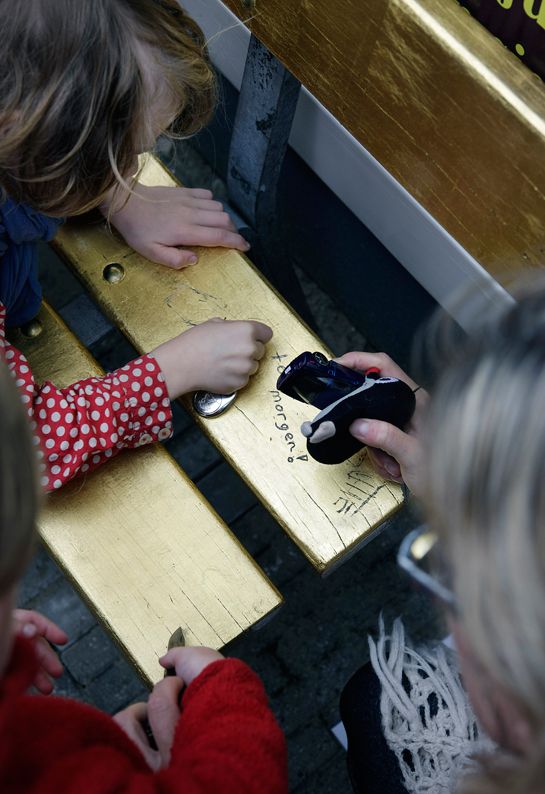
Sarah van Sonsbeeck (NL) MUNICIPALITY OF SILENCE, 2013
Sculpture,
Zeilstraat 54, Amsterdam
Sarah van Sonsbeeck has a background in architecture and fine art, and has therefore developed an interdisciplinary way of working. She has a detailed eye for the architectonic experience of her installations and focuses on silence, human interaction and the relational ownership of space. The conceptual character of her work shows a poetic sensibility, while her choices in form and materiality are both functional and well considered.
For KadS, Van Sonsbeeck is seeking to interact with the public. Her installation ‘Municipality of Silence’ comprises a municipal bench covered with 22-karat gold leaf, which is placed in front of a gold shop in the Zeilstraat. Gold is generally considered to be a safe investment. The work speaks to the imagination in this location, particularly in our current economic crisis. Visitors are invited to actively participate in the artwork by carving a message into the bench, and taking a bit of gold away with them. The artwork consists of the transformation of an everyday street object. Contributions made by visitors, who add their own stories, are an essential part of this transfiguration. As such, the ‘silent’ installation acquires a history, and hereby reveals a layering.
Sarah van Sonsbeeck [Utrecht, 1976] studied Architecture at TU Delft, and Fine Art at the Gerrit Rietveld Academie and the Rijksakademie van Beeldende Kunsten in Amsterdam. She has exhibited at the Stedelijk Museum Amsterdam, Museum Abteiberg, Mönchengladbach and the Van Abbemuseum. She is represented by Annet Gelink Gallery in Amsterdam.
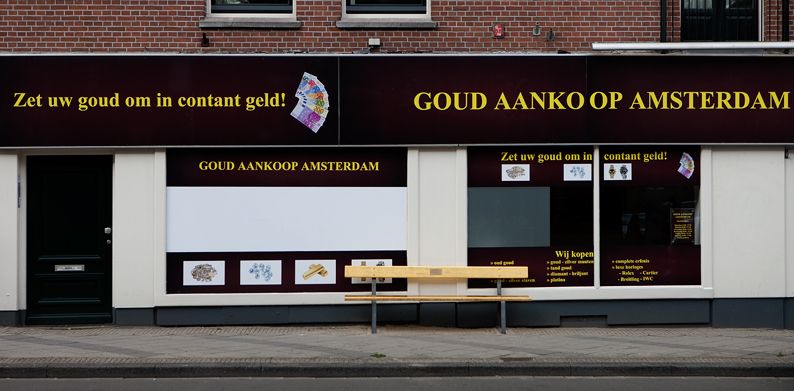
Sarah van Sonsbeeck (NL) MUNICIPALITY OF SILENCE, 2013
Sculpture,
Zeilstraat 54, Amsterdam
Sarah van Sonsbeeck has a background in architecture and fine art, and has therefore developed an interdisciplinary way of working. She has a detailed eye for the architectonic experience of her installations and focuses on silence, human interaction and the relational ownership of space. The conceptual character of her work shows a poetic sensibility, while her choices in form and materiality are both functional and well considered.
For KadS, Van Sonsbeeck is seeking to interact with the public. Her installation ‘Municipality of Silence’ comprises a municipal bench covered with 22-karat gold leaf, which is placed in front of a gold shop in the Zeilstraat. Gold is generally considered to be a safe investment. The work speaks to the imagination in this location, particularly in our current economic crisis. Visitors are invited to actively participate in the artwork by carving a message into the bench, and taking a bit of gold away with them. The artwork consists of the transformation of an everyday street object. Contributions made by visitors, who add their own stories, are an essential part of this transfiguration. As such, the ‘silent’ installation acquires a history, and hereby reveals a layering.
Sarah van Sonsbeeck [Utrecht, 1976] studied Architecture at TU Delft, and Fine Art at the Gerrit Rietveld Academie and the Rijksakademie van Beeldende Kunsten in Amsterdam. She has exhibited at the Stedelijk Museum Amsterdam, Museum Abteiberg, Mönchengladbach and the Van Abbemuseum. She is represented by Annet Gelink Gallery in Amsterdam.
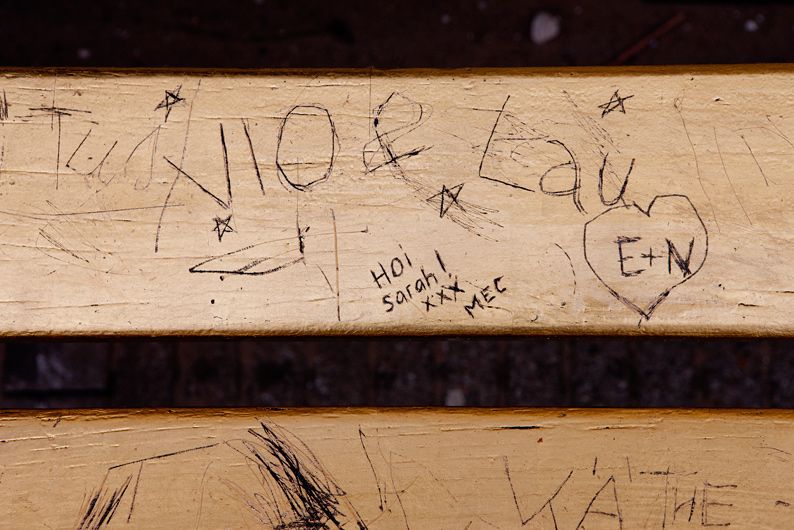
Sarah van Sonsbeeck (NL) MUNICIPALITY OF SILENCE, 2013
Sculpture,
Zeilstraat 54, Amsterdam
Sarah van Sonsbeeck has a background in architecture and fine art, and has therefore developed an interdisciplinary way of working. She has a detailed eye for the architectonic experience of her installations and focuses on silence, human interaction and the relational ownership of space. The conceptual character of her work shows a poetic sensibility, while her choices in form and materiality are both functional and well considered.
For KadS, Van Sonsbeeck is seeking to interact with the public. Her installation ‘Municipality of Silence’ comprises a municipal bench covered with 22-karat gold leaf, which is placed in front of a gold shop in the Zeilstraat. Gold is generally considered to be a safe investment. The work speaks to the imagination in this location, particularly in our current economic crisis. Visitors are invited to actively participate in the artwork by carving a message into the bench, and taking a bit of gold away with them. The artwork consists of the transformation of an everyday street object. Contributions made by visitors, who add their own stories, are an essential part of this transfiguration. As such, the ‘silent’ installation acquires a history, and hereby reveals a layering.
Sarah van Sonsbeeck [Utrecht, 1976] studied Architecture at TU Delft, and Fine Art at the Gerrit Rietveld Academie and the Rijksakademie van Beeldende Kunsten in Amsterdam. She has exhibited at the Stedelijk Museum Amsterdam, Museum Abteiberg, Mönchengladbach and the Van Abbemuseum. She is represented by Annet Gelink Gallery in Amsterdam.
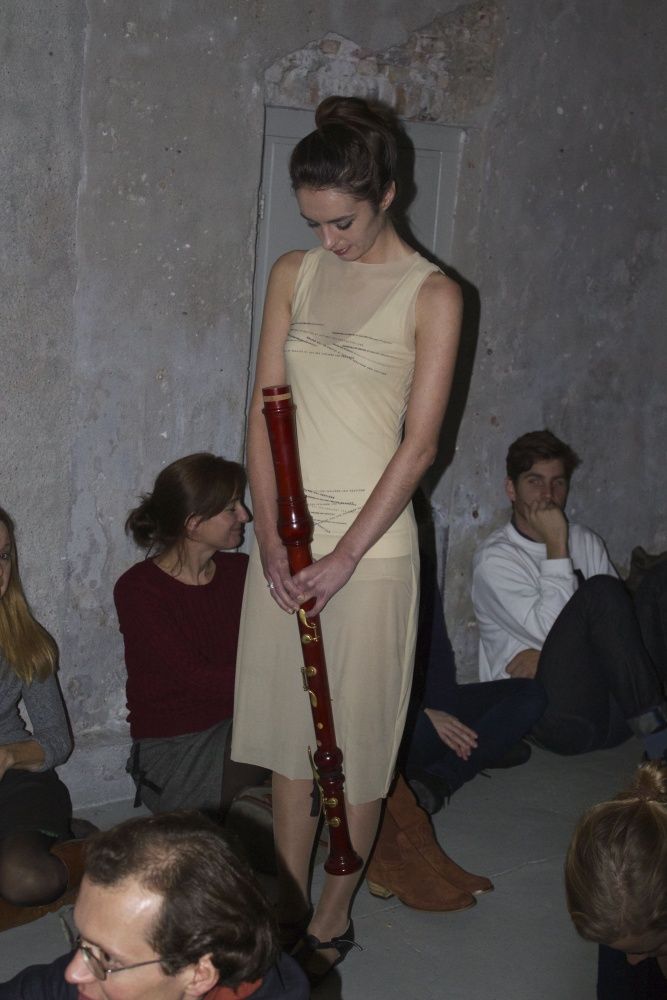
Sarah van Sonsbeeck (NL) MUNICIPALITY OF SILENCE, 2013
Sculpture,
Zeilstraat 54, Amsterdam
Sarah van Sonsbeeck has a background in architecture and fine art, and has therefore developed an interdisciplinary way of working. She has a detailed eye for the architectonic experience of her installations and focuses on silence, human interaction and the relational ownership of space. The conceptual character of her work shows a poetic sensibility, while her choices in form and materiality are both functional and well considered.
For KadS, Van Sonsbeeck is seeking to interact with the public. Her installation ‘Municipality of Silence’ comprises a municipal bench covered with 22-karat gold leaf, which is placed in front of a gold shop in the Zeilstraat. Gold is generally considered to be a safe investment. The work speaks to the imagination in this location, particularly in our current economic crisis. Visitors are invited to actively participate in the artwork by carving a message into the bench, and taking a bit of gold away with them. The artwork consists of the transformation of an everyday street object. Contributions made by visitors, who add their own stories, are an essential part of this transfiguration. As such, the ‘silent’ installation acquires a history, and hereby reveals a layering.
Sarah van Sonsbeeck [Utrecht, 1976] studied Architecture at TU Delft, and Fine Art at the Gerrit Rietveld Academie and the Rijksakademie van Beeldende Kunsten in Amsterdam. She has exhibited at the Stedelijk Museum Amsterdam, Museum Abteiberg, Mönchengladbach and the Van Abbemuseum. She is represented by Annet Gelink Gallery in Amsterdam.
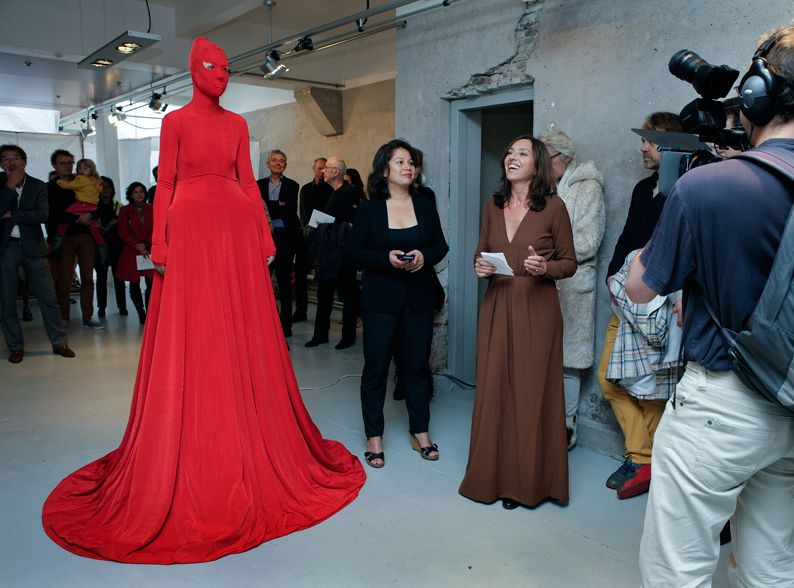
Yasmijn van Karhof (NL) INNER SPACE/OUTER SPACE, 2013
Film installation,
Koninginneweg 225, Amsterdam
Visual artist Yasmijn Karhof has particularly expressed herself through the medium of film over the last few years. She is concerned with the perception of reality, especially with regards to the notion of how the imagination is able to play and colour perception. Karhof’s films have a sensitive, melancholic feel to them: they seem to render the everyday, yet a surreal and alienating atmosphere gradually emerges.
For KadS, Karhof is presenting ‘Inner space/Outer space’, an installation comprising a film screen featuring the same woman on either side. The artist evokes the suggestion that you could get to know her better. But an encounter fails to occur. Karhof: ‘This work revolves around the desire to truly know the other and the impossibility of this’. The film ‘Inner space/Outer space’ was granted the BNG Workspace Award. According to the jury, Yasmijn Karhof has captured the spirit of the
times with her film: ‘She is able, in a conceptual and poetic manner, to translate the desire for peace and contemplation in a hectic urban environment into a seemingly simple image. The interactive element entices the viewer to move closer to the work and at the same time emphasises the illusion that is film’.
Yasmijn Karhof [Edam, 1974] studied at the Gerrit Rietveld Academie, The Cooper Union School of Art in New York and the Rijksakademie van beeldende kunsten in Amsterdam. She works with photography, film, performance and installations in a variety of combinations. Karhof has exhibited at the Centraal Museum, Utrecht, Museum De Paviljoens, Almere, Stedelijk Museum ’s-Hertogenbosch, Youkobo Art Space in Tokyo and the Living Art Museum in Reykjavik.INNER SPACE/OUTER SPACE, 2012
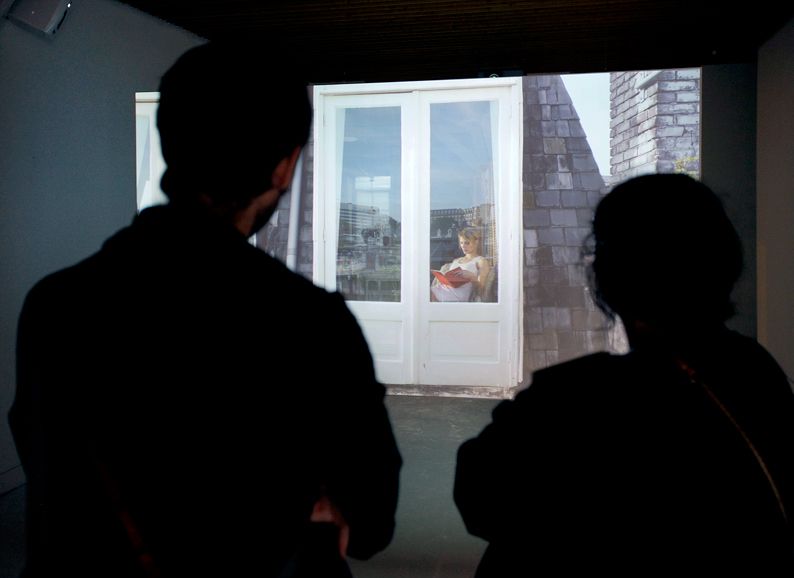
Yasmijn van Karhof (NL) INNER SPACE/OUTER SPACE, 2013
Film installation,
Koninginneweg 225, Amsterdam
Visual artist Yasmijn Karhof has particularly expressed herself through the medium of film over the last few years. She is concerned with the perception of reality, especially with regards to the notion of how the imagination is able to play and colour perception. Karhof’s films have a sensitive, melancholic feel to them: they seem to render the everyday, yet a surreal and alienating atmosphere gradually emerges.
For KadS, Karhof is presenting ‘Inner space/Outer space’, an installation comprising a film screen featuring the same woman on either side. The artist evokes the suggestion that you could get to know her better. But an encounter fails to occur. Karhof: ‘This work revolves around the desire to truly know the other and the impossibility of this’. The film ‘Inner space/Outer space’ was granted the BNG Workspace Award. According to the jury, Yasmijn Karhof has captured the spirit of the
times with her film: ‘She is able, in a conceptual and poetic manner, to translate the desire for peace and contemplation in a hectic urban environment into a seemingly simple image. The interactive element entices the viewer to move closer to the work and at the same time emphasises the illusion that is film’.
Yasmijn Karhof [Edam, 1974] studied at the Gerrit Rietveld Academie, The Cooper Union School of Art in New York and the Rijksakademie van beeldende kunsten in Amsterdam. She works with photography, film, performance and installations in a variety of combinations. Karhof has exhibited at the Centraal Museum, Utrecht, Museum De Paviljoens, Almere, Stedelijk Museum ’s-Hertogenbosch, Youkobo Art Space in Tokyo and the Living Art Museum in Reykjavik.INNER SPACE/OUTER SPACE, 2012
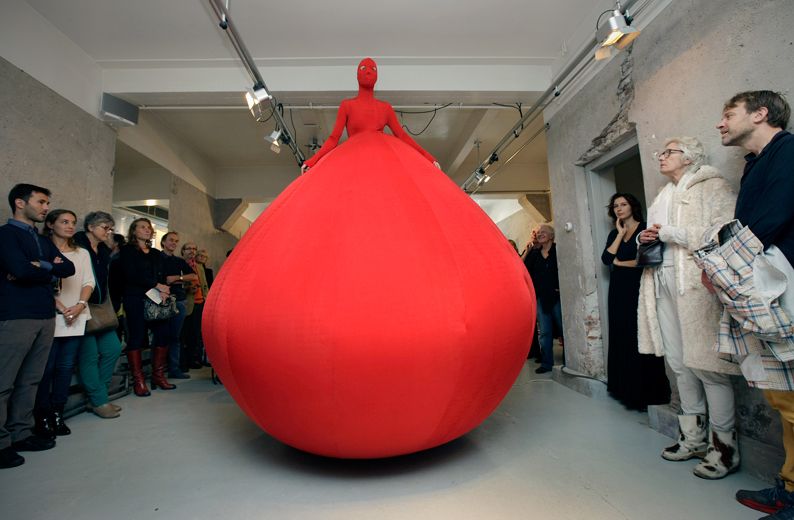
Yasmijn van Karhof (NL) INNER SPACE/OUTER SPACE, 2013
Film installation,
Koninginneweg 225, Amsterdam
Visual artist Yasmijn Karhof has particularly expressed herself through the medium of film over the last few years. She is concerned with the perception of reality, especially with regards to the notion of how the imagination is able to play and colour perception. Karhof’s films have a sensitive, melancholic feel to them: they seem to render the everyday, yet a surreal and alienating atmosphere gradually emerges.
For KadS, Karhof is presenting ‘Inner space/Outer space’, an installation comprising a film screen featuring the same woman on either side. The artist evokes the suggestion that you could get to know her better. But an encounter fails to occur. Karhof: ‘This work revolves around the desire to truly know the other and the impossibility of this’. The film ‘Inner space/Outer space’ was granted the BNG Workspace Award. According to the jury, Yasmijn Karhof has captured the spirit of the
times with her film: ‘She is able, in a conceptual and poetic manner, to translate the desire for peace and contemplation in a hectic urban environment into a seemingly simple image. The interactive element entices the viewer to move closer to the work and at the same time emphasises the illusion that is film’.
Yasmijn Karhof [Edam, 1974] studied at the Gerrit Rietveld Academie, The Cooper Union School of Art in New York and the Rijksakademie van beeldende kunsten in Amsterdam. She works with photography, film, performance and installations in a variety of combinations. Karhof has exhibited at the Centraal Museum, Utrecht, Museum De Paviljoens, Almere, Stedelijk Museum ’s-Hertogenbosch, Youkobo Art Space in Tokyo and the Living Art Museum in Reykjavik.INNER SPACE/OUTER SPACE, 2012
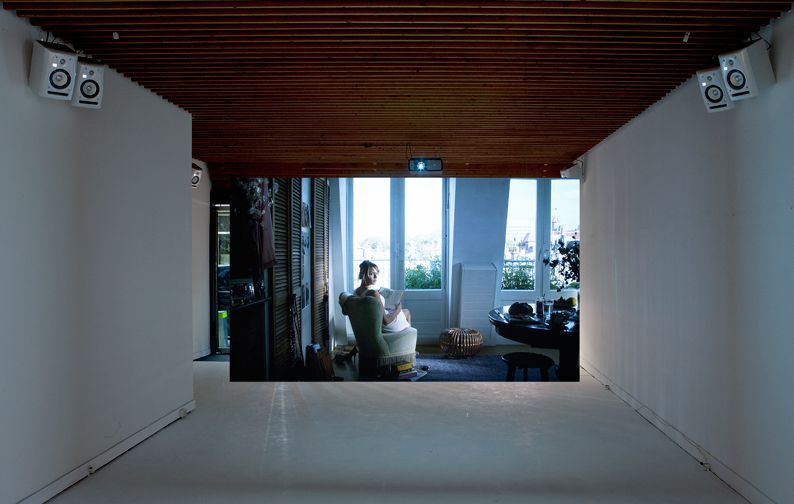
Yasmijn van Karhof (NL) INNER SPACE/OUTER SPACE, 2013
Film installation,
Koninginneweg 225, Amsterdam
Visual artist Yasmijn Karhof has particularly expressed herself through the medium of film over the last few years. She is concerned with the perception of reality, especially with regards to the notion of how the imagination is able to play and colour perception. Karhof’s films have a sensitive, melancholic feel to them: they seem to render the everyday, yet a surreal and alienating atmosphere gradually emerges.
For KadS, Karhof is presenting ‘Inner space/Outer space’, an installation comprising a film screen featuring the same woman on either side. The artist evokes the suggestion that you could get to know her better. But an encounter fails to occur. Karhof: ‘This work revolves around the desire to truly know the other and the impossibility of this’. The film ‘Inner space/Outer space’ was granted the BNG Workspace Award. According to the jury, Yasmijn Karhof has captured the spirit of the
times with her film: ‘She is able, in a conceptual and poetic manner, to translate the desire for peace and contemplation in a hectic urban environment into a seemingly simple image. The interactive element entices the viewer to move closer to the work and at the same time emphasises the illusion that is film’.
Yasmijn Karhof [Edam, 1974] studied at the Gerrit Rietveld Academie, The Cooper Union School of Art in New York and the Rijksakademie van beeldende kunsten in Amsterdam. She works with photography, film, performance and installations in a variety of combinations. Karhof has exhibited at the Centraal Museum, Utrecht, Museum De Paviljoens, Almere, Stedelijk Museum ’s-Hertogenbosch, Youkobo Art Space in Tokyo and the Living Art Museum in Reykjavik.INNER SPACE/OUTER SPACE, 2012